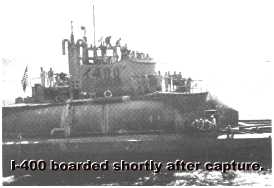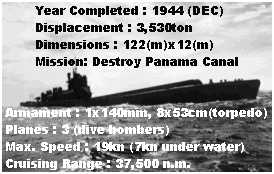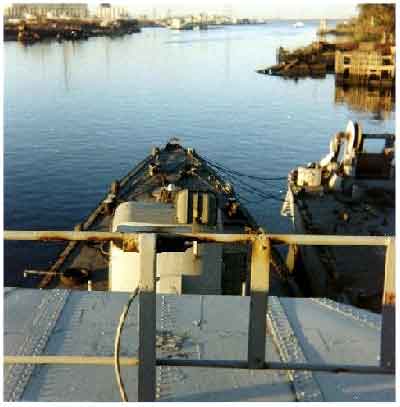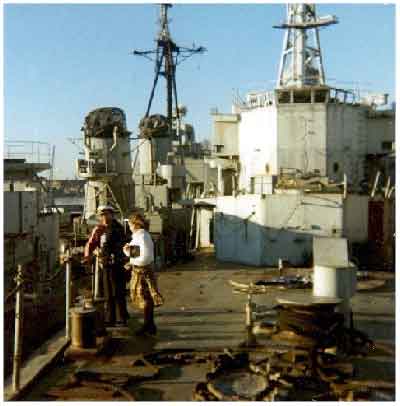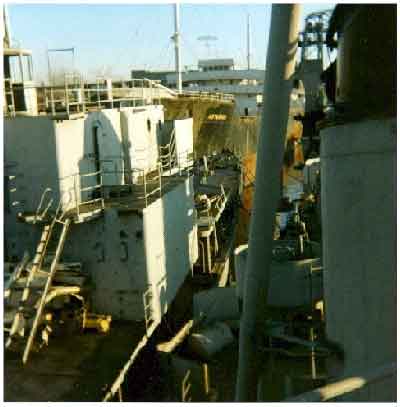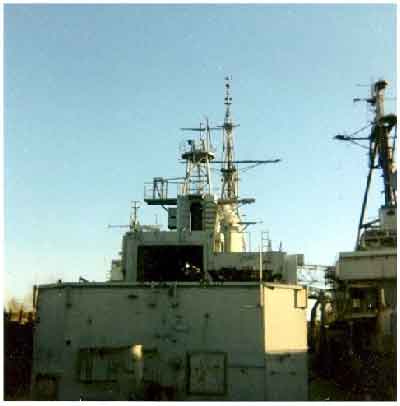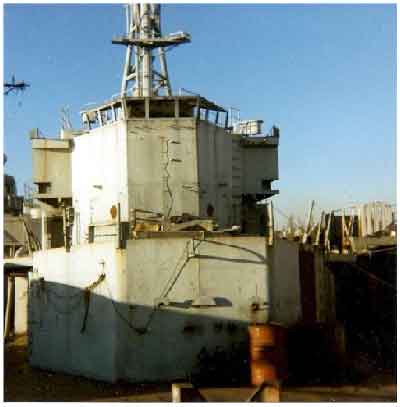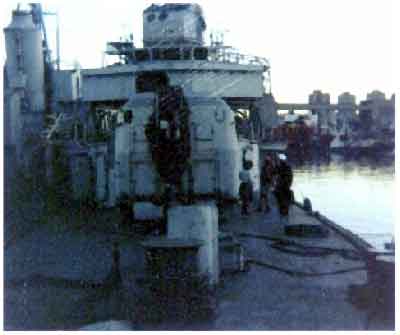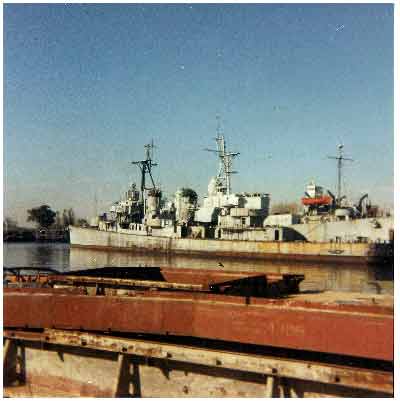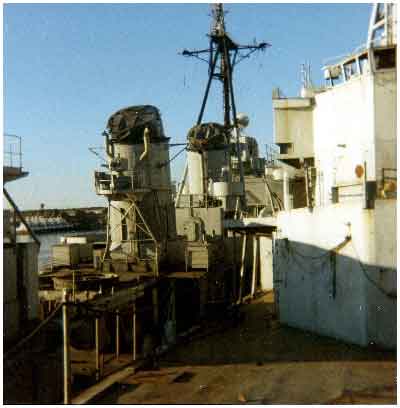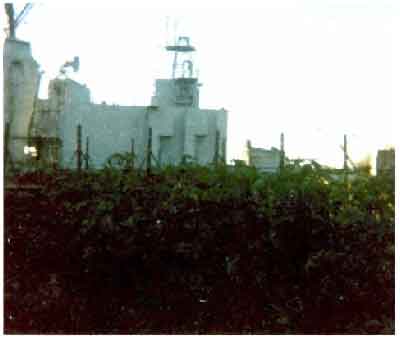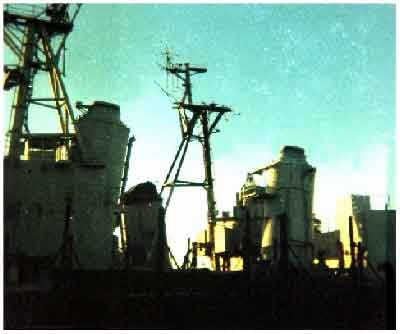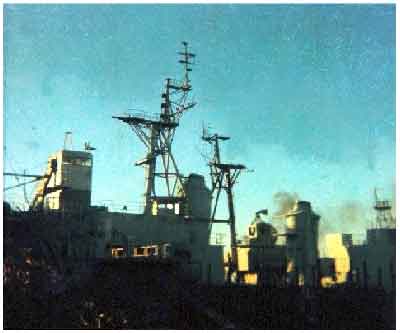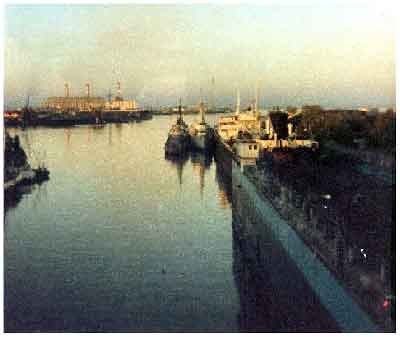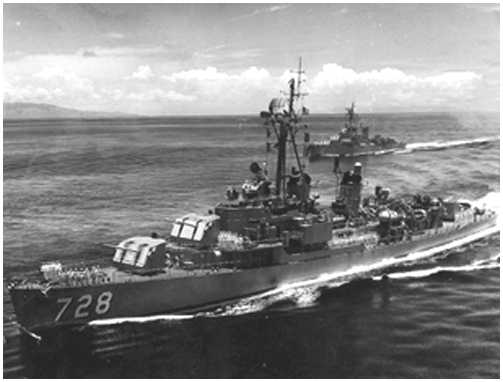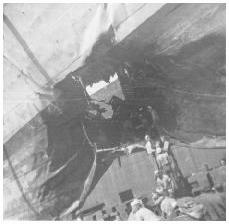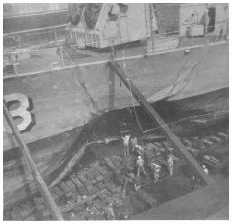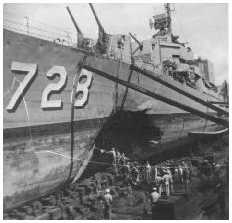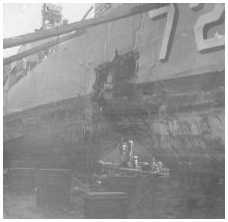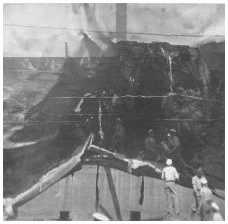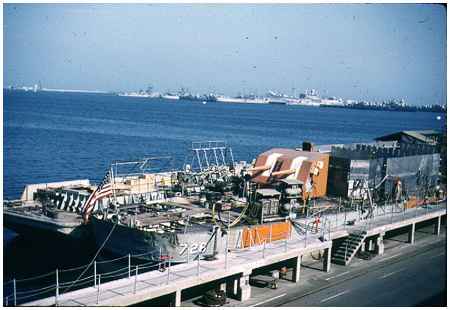Vietnam Korea Inchon Invasion Mine Incident A-Bomb
History Overview:
At this time, I would like to acknowledge Karl Kristiansen, who was the webmaster for many years and compiled so much of what we have here today.
I would also like to thank Richard A. Bowman for permission to use selections and photographs from his book “A Tin Can Named Mansfield: A History of the USS Mansfield (DD728).” There were not many copies of this work published and feel this is a way as many people as possible can view this comprehensive history of our ship.
Richard A. Bowman enlisted in the Navy, March 1948. His shipboard assignment to the Mansfield was from the summer of 1948 until late 1950. He served two tours of duty in the Korean War. First aboard the Mansfield, and then reassignment to the USS Tortuga (LSD-26), which had been mobilized and recommissioned from the mothball fleet. Tortuga deployed to Korea via Japan from December 1950 until March 1952. He was honorably discharged from the Navy at San Francisco, CA, 29 October 1952, a Quartermaster Second Class Petty Officer, having served four years, seven months and six days.
I would also like to thank all individuals who have donated pictures and documents. I have given credit where the source is known. If anyone finds inaccuracies or has further information please contact me.
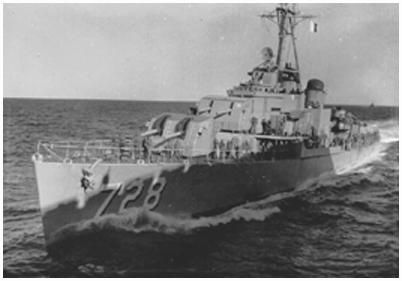 |
 For the Official U.S. Navy “Welcome Aboard” go here. For the Official U.S. Navy “Welcome Aboard” go here. |
| DD-728:Displacement – 2,200 Length – 376′ 6″ Beam – 40′ 10″ Dr.- 15′ 8″ Speed – 34.2kt Compliment – 345Armaments: 6 – 5″ .38’s [ More Info ] 12 – 40mm [ More Info ] 10 – 21″ tt [ More Info ]Class: Allen M. Sumner |
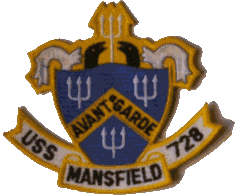 |
 The MANSFIELD was part of America’s wartime naval build-up, which saw United States Shipyards deliver some 390 destroyers to the Navy during the course of World War-II. Her Active duty spanned three wars; World War-II, Korea, and Vietnam.
The MANSFIELD was part of America’s wartime naval build-up, which saw United States Shipyards deliver some 390 destroyers to the Navy during the course of World War-II. Her Active duty spanned three wars; World War-II, Korea, and Vietnam.
The destroyer was named in honor of Sergeant Duncan Mansfield, a United States Marine. According to the Marine Corps Historical Center, Mansfield was born at Albany, N.Y. The date of his original enlistment (3 years) 11 August 1798; place of enlistment Philadelphia, PA. Age at time of enlistment, 25 years and 7 months. He was discharged 29 July 1801 and re-enlisted (3 years) 30 July 1801 and finally discharged, 2 April 1805. He entered on board the U.S. Schooner ENTERPRIZE as a Sergeant on April 5, 1803. He was transferred to the U.S. Frigate JOHN ADAMS on September 20, 1804. He was returned to the United States in the JOHN ADAMS and detached March 24, 1805. While serving on the schooner ENTERPRIZE during the war with Tripoli in 1804, Sgt. Mansfield volunteered for an expedition led by Lt. Stephen Decatur, Jr. On February 16, Decatur and his 84-man crew sailed the captured Tripolitan ketch, renamed INTREPID, disguised as an Arabian ship, into Tripoli Harbor to destroy the captured U.S. frigate PHILADELPHIA to prevent her use against the United States. Lord Nelson called the action, “the most bold and daring act of the age.”
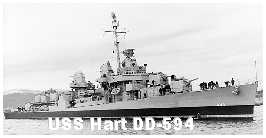 The name Mansfield was canceled for DD-594 and reassigned to DD-728 on 26 July 1943. DD-594 was renamed Hart (q.v.) on 21 March 1944 before launching.
The name Mansfield was canceled for DD-594 and reassigned to DD-728 on 26 July 1943. DD-594 was renamed Hart (q.v.) on 21 March 1944 before launching.
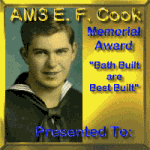 MANSFIELD (DD728) was launched 29 January 1944 at the Bath Iron Works Corp., Bath, Maine, and commissioned 14 April 1944, with Cmdr. Robert E. Brady Jr., in command.
MANSFIELD (DD728) was launched 29 January 1944 at the Bath Iron Works Corp., Bath, Maine, and commissioned 14 April 1944, with Cmdr. Robert E. Brady Jr., in command.
After completion of her shake-down cruise off Bermuda, MANSFIELD steamed via the Panama Canal, to the west coast arriving in San Diego, 10 September 1944. A week later in company with Destroyer Division-122, she headed for Pearl Harbor, conducting intensive training en route. After further training exercised at Pearl Harbor, MANSFIELD and four other destroyers escorted a convoy to Ulithi Atoll; a 19-mile long, 10-mile wide, crescent-shaped coral island, in the West Caroline Islands of the Western Pacific, six thousand miles from San Diego – their base for the next six months.
From shipmate C.W. McQueen [12.21.01]: “I went aboard the Mansfield in February 1944 and we took her on a shakedown cruise to Bermuda. On a high speed run we achieved 38.9 knots. This was with a clean [ new ] hull without marine growth. The ship was commissioned about mid April and immediately left for the Panama Canal. Through the Panama Canal and a one day layover in Panama, then on to San Diego and a 3 day layover. We then went on to Port Chicago for ammunition, and on to Pearl Harbor. We were there for 2 or 3 days and then left for the Western Pacific. If my memory is correct, our first action was in June and consisted of shelling an island and laying down a smoke screen in preparation for Marines to land. My memory tells me that we had several engagements prior to the posted September 1944 arrival date.
Some other memories not posted are:
- A high speed run into Saigon Harbor to bottle up the Japanese fleet. Thank God they weren’t there. We ran down a wooden vessel when leaving the harbor.
- The Mansfield shot down 17 Kamikazes in one day off Okinawa.
- The Mansfield stood by the cruiser Pittsburgh when she broke in two during the typhoon off of Oaranawa.
- The Mansfield received the Presidential Unit Citation for Excellence in engineering.
These are some of my memories and I will admit that memories can indeed be misleading.” – C W Mc Queen WT 1/c 1944-45
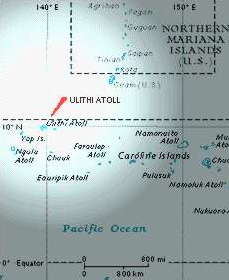 Ulithi, captured from the Japanese on 23 September, was wanted and used for its big and deep lagoon. It was the strategic advanced fleet base for Task Force 38 and 58 – the Navy’s main striking arm: the Fast Carrier Forces Pacific Fleet. Ulithi, was said to be the best anchorage in its part of the Pacific and could shelter a thousand ships in its vast lagoon.
Ulithi, captured from the Japanese on 23 September, was wanted and used for its big and deep lagoon. It was the strategic advanced fleet base for Task Force 38 and 58 – the Navy’s main striking arm: the Fast Carrier Forces Pacific Fleet. Ulithi, was said to be the best anchorage in its part of the Pacific and could shelter a thousand ships in its vast lagoon.
Under a dual fleet command setup, the Third Fleet Shared the same naval force with the Fifth Fleet. While one fleet commander and his staff were at sea operating against the Japanese, the other commander and staff would be ashore at Pearl Harbor planning the next operation. Admiral William F. Halsey commanded the Third Fleet from June 1944 until November 1945. Commanding the Fifth Fleet from March 1944 until May 1945, was Admiral Chester W. Nimitz, commander-in-chief of the Pacific Fleet.
Vice Admiral Mark A. Mitschner, commanded Task Force 38 – the Fast Carrier Force: the Enterprise and eight Essex class carriers, eight Independence class light carriers, with an ample screen of two new battleships, three cruisers and 14-destroyers.
A Task Force is organized for a specific type of operation and their designation is based on fleet assignments: thus Task force 38 and 58, was the carrier striking force of the Third or Fifth Fleet, with subordinate Task Groups designated as 30.1, 38.1, 38.2 or 58.1, etc.
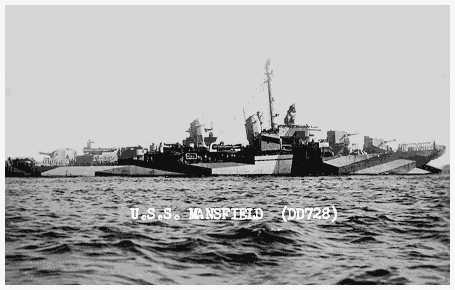
Upon arrival at Ulithi, MANSFIELD joined Task Group 38.1 (commanded by Vice Admiral John S. McCain) to screen for the carriers and served as a picket during air strikes against central Luzon, including the Manila area of the Philippines. On 10 December 1944, MANSFIELD, with Destroyer Squadron-61 in task Group 38.2 (commanded by Read Admiral Gerald F. Bogan) screened for carrier raids on Luzon, in support of the Leyte invasion. After several successful strikes, and the horrors of a sudden typhoon which generated waves 50 to 60 feet high, capsizing destroyers Hull, Spence, and Monaghan; MANSFIELD’s task group picked up survivors and returned to Ulithi. Halsey’s fleet suffered significant damage from the typhoon, and his failure to take proper precautions was regarded as the principal reason, although he was only mildly reprimanded. A similar lapse during a June 1945 typhoon was less favorably viewed and he was nearly relieved of command.
MANSFIELD joined Task Group 30.1 on 30 December, and screened for carrier air strikes against Formosa and central Luzon. Afterwards, Halsey took the Third Fleet with Task Group 30.1, through the Bashi Strait into the South China Sea until 20 January 1945. No Japanese units challenged Halsey’s fleet during its 3,800 mile foray which spewed destruction on Formosa, Luzon, and Japanese shipping along the Vietnamese and China coast from Hong Kong to Saigon. The Third Fleet battered enemy facilities and merchant ships and destroyed 112 Japanese planes.
In February 1945, three days prior to Iwo Jima D-day, MANSFIELD screened with the Fifth Fleet in Task Group 58.1 (commanded by Rear Admiral Joseph J. Clark) as carrier air strikes were launched against targets over and around Tokyo. The raids were conducted not only as a shield for Iwo Jima, but to destroy enemy planes and reduce the Japanese capability for launching air attacks. From 17 to 23 February, she screened in Task Group 58.1 during carrier attacks for the Iwo Jima assault, and then steamed at full speed back to the Tokyo area for bombing runs on Nagoya and Koybe. Heavy weather set in, and the task group retired southward, blasting enemy shore installations on Okinawa while en route to Ulithi for replenishment.
From 14 March to 27 April 1945, MANSFIELD screened for carrier strikes against southern Kyushu, followed by sweeps against Okinawa Gunto. On 9 May 1945, the carriers again pounded Kyushu, Okinawa, and the island groups in between. Mitschner’s carriers while supporting the Iwo Jima and Okinawa landings, and raids on Japan and Formosa, suffered heavily from Kamikaze attacks.
Okinawa in April, May and June was worse for the Navy, “the most costly naval operation in naval history,” according to the historian Elmer B. Potter. The Fifth Fleet lost 34 vessels sunk and 368 damaged, many irreparably. About five thousand sailors died, and almost that number wounded, many grotesquely burned. In May, Mitschner had to shift his flag twice; from the carrier Bunker Hill, to the Enterprise, to the Randolph, as each carrier was seriously damaged. Toward the end of May, Nimitz relieved Spruance and Mitschner who were stressed almost beyond endurance by remaining continuously on station at the two invasions.
From 28 May, when Halsey came back the Fifth Fleet became Third Fleet once again, and Task Group 58.1 became Task Group 38.1. It began to rove along Japanese waters as soon as Okinawa was “secured” on 21 June. Admiral John S. McCain now commanding Task Force 38 raided Tokyo and other targets along the Japanese coast with impunity. On 17 July, Halsey’s 105 ship armada hit the large naval base at Yokosuka, outside of Tokyo. Three weeks before V-J Day, MANSFIELD with eight destroyers of Destroyer Squadron-61, conducted a daring high-speed torpedo run into Nojima Saki, sinking or damaging four enemy ships.
To learn more about the I-400 go here.
A new browser window will open. Please close it when done to return here.
On 27 August 1945, assisted by another destroyer, the USS Blue (DD-744), the MANSFIELD captured the Japanese submarine I-400 off the coast of Honshu.
The atomic age was born on 6 August when the Air Force B-29 super fortress “Enola Gay” dropped the first atomic bomb at Hiroshima. The 20th Air Force dropped a second atomic bomb on Nagasaki on 9 August. It was all over. Nimitz ordered Halsey to “cease Fire” on 15 August.
After witnessing the formal Japanese surrender ceremony on Sunday, 2 September 1945 in Tokyo Bay, MANSFIELD returned to the west coast.
The United States Navy’s mastery of the seas at the close of World War-II was without historical precedent. The war was finally over, and it was time to bring the “boys” home. Their implements of war were discarded or, in the case of hundreds of navy ships, put into “moth balls”, a system of preservation and storage. A few ships launched before termination of hostilities did manage to enter the active ranks.
Such was the case with the MANSFIELD. She returned again to the Far East as part of the Seventh Fleet from March 1946 to February of 1947. After performing patrol duties along the Chinese, Korean and Japanese coasts she steamed home to San Diego.

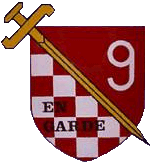 For the next two and one-half years, she trained both her own crew and reservists from the west coast and made annual cruises to the Western Pacific as part of Cruiser destroyer Force Pacific Fleet. MANSFIELD was flag ship for Destroyer Squadron Nine: the DeHaven (DD727), Lyman K. Swenson (DD729) and Collett (DD730).
For the next two and one-half years, she trained both her own crew and reservists from the west coast and made annual cruises to the Western Pacific as part of Cruiser destroyer Force Pacific Fleet. MANSFIELD was flag ship for Destroyer Squadron Nine: the DeHaven (DD727), Lyman K. Swenson (DD729) and Collett (DD730).
On 1 May 1950, Destron9 departed San Diego for duty in the Far East, Arriving 31 May at Yokosuka, Japan. After replenishment and several days stay, Desron9 deployed to Sasebo, Japan.
On 26 June, one day after North Korean forces invaded South Korea, MANSFIELD and Desron9, steamed from Sasebo to South Korea to rendezvous with evacuation vessels from Inchon. Beginning 27 June, the destroyers provided blockade, shore bombardment and escort services along the enemy coast of Korea until 8 September 1950.
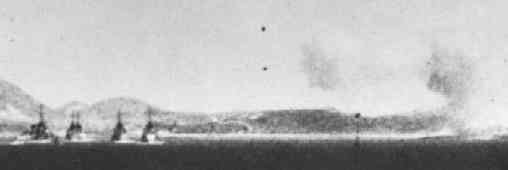
Five US Navy destroyers steam up the Inchon Channel for the bombardment of Wolmi Do Island, on 13 Sept 1950. Note smoke rising from proceeding air strikes on the island. The ships are USS MANSFIELD (DD-728), DEHAVEN (DD-727), LYMAN K. SWENSON (DD-729), COLLETT (DD-730) AND GURKE (DD-783).
Go here for more details on MANSFIELD’s role in the Inchon Invasion.
The morning of 13 September, as a unit of the United Nations invasion force en route from Sasebo to Inchon, six destroyers, led by MANSFIELD, with DeHaven, Swenson, Collett, Gurke and Henderson, were directed on a reconnaissance in force: attack to discover the position and strength of the enemy.
They broke for the main task group, seven to ten miles southwest of Inchon, and nosed single file, 700 yards apart, slowly up the narrow Flying Fish Channel into Inchon Harbor.Ordered to anchorages in the harbor close to Wolmi-Do Island, and expose itself, openly inviting enemy shore batteries on island open-fire, for the purpose of locating their gun positions; Desron9 won the appropriate title, “the Sitting Duck Squadron”.
Their job, which they shared with the air attack element, was to knock out selected targets, principally enemy batteries along the sea wall and some emplacements on the hills of the city. Once the enemy guns on the island began firing, MANSFIELD and the other destroyers smothered them with a near point-blank barrage.
During the intense ship-shore artillery duel, the Collett received five hits by counter fire, sustaining considerable damage and wounding four of her men. Enemy shells hit the Gurke three times, wounding two men, but caused no serious damage to the ship. The Swenson suffered two casualties from a near miss: one was Lt.(jg) David H. Swenson, nephew of the officer for whom the ship was named. He was the only American killed during the assault. During the 48-minute battle a total of 25 shell geysers were observed all around the MANSFIELD. Five were close aboard, but somehow, miraculously, she was no touched.
A second reconnaissance in force, was carried out on 14 September, similar to the previous day. MANSFIELD proceeded up the channel in the lead of the destroyer unit, passing Wolmi-Do without incident. They did however, fire upon and destroy more gun emplacements on the beach, and in the hills of the city.
The next approach to the target area was made early on D-Day the 15th September. MANSFIELD, again leading the entire invasion fleet, dropped anchor during early morning darkness in the innermost berth in Inchon Harbor, firing on visually selected targets along the waterfront prior to the landing of troops. Later that morning, 34-minutes after the first landing wave arrived on Wolmi-Do, the island was reported secured.
Go here for more Korean conflict details.
For their gallantry, the six destroyers received the Navy Unit Commendation and the Korean Presidential Unit Citation.
Click ribbon ![]() for unit citation and newspaper report.
for unit citation and newspaper report.
Two weeks after Inchon, MANSFIELD, while searching for a downed Air Force B-26 bomber, struck a mine which served the bow below the main deck. The ship’s casualties totaled twenty-eight, nine of whom required transfer to the cruiser Helena for surgical treatment and later to a hospital. After making her way to dry dock in Sasebo, and receiving a stub bow, she steamed to the Naval Shipyard at Bremerton, Washington, for major repairs and bow replacement. She rejoined the United Nations Fleet again, off South Korea late in 1951 for gun fired support escort, and shore bombardment duty.
Go here for full details of this incident.
“I was only on the Mansfield (TAD) from, mid-December ’51 until mid-January ’52. When I left, my orders were signed by a “MacMillan”. I don’t recall anyone in particular. We were regularly engaged by shore batteries fired from caves in the hills surrounding Wonsan harbor. We were supporting minesweepers clearing the Slot – a firing area near the coast from which 5″ guns could reach the railroad yards in town. We also supported a detachment of the 41st Royal Commandos based on a small islet close to the mainland.” – Lt(jg) Jerry Krupp
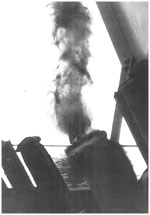 On 9 November 1952, the Mansfield encountered a floating mine and sank same. For details of this event, please go here.
On 9 November 1952, the Mansfield encountered a floating mine and sank same. For details of this event, please go here.
After Korea, MANSFIELD alternated between duty in the Western Pacific and training west coast reservists. She was overhauled in the fall of 1955 at the Naval Shipyard, Long Beach, California.
From May 1958-Aug. 1958, MANSFIELD, as part of Joint Task Force 7.3 participated in Operation Hardtack 1. This was a series of nuclear tests held in the Pacific testing area. For more details go here .
According to shipmate Larry Lawton, “The MANSFIELD departed 17 July 1959 for WestPac. We were there with the Collett, DeHaven and Benner. Lifeguard for the Lexington, Taiwan patrol, etc.” Larry adds, “Do you recall the radio call sign of the MANSFIELD? TACTICS.”
To read messages describing this deployment go here .
 She returned to the Naval shipyard in Long Beach in 1960 as part of the Fleet Rehabilitation and Modernization (FRAM) program. the overhaul extensively modernized her, replacing the 3-inch/50 caliber guns with Mark-32, triple tube anti-submarine warfare torpedoes. The after super structure was reconfigured with a hanger for the drone anti-submarine helicopter (DASH) and variable-depth sonar equipment. Machinery was over hauled, new electronic equipment was installed, and living and working spaces were rehabilitated.
She returned to the Naval shipyard in Long Beach in 1960 as part of the Fleet Rehabilitation and Modernization (FRAM) program. the overhaul extensively modernized her, replacing the 3-inch/50 caliber guns with Mark-32, triple tube anti-submarine warfare torpedoes. The after super structure was reconfigured with a hanger for the drone anti-submarine helicopter (DASH) and variable-depth sonar equipment. Machinery was over hauled, new electronic equipment was installed, and living and working spaces were rehabilitated.
Shipmate Tom Harper adds, “The DASH pictured is a SNOOPY bird (C version) that we would send over NVN to do our own gun spotting. It had a TV camera and a still camera mounted on a “sled” that attached to the hard mounts where a torpedo would normally go. We probably had the most successful use of this system. This bird has extra fuel tanks that tripled the aloft time to three hours (105 gal. of fuel).” Go here for an interesting story concerning the DASH from Capt. Jack Griffin and a poem dedicated to Snoopy submitted by Gary Wigley.
From October 1960 to October 1961, the modernized destroyer conducted training exercises with the First Fleet off the west coast (According to Larry Lawton “After the modification we spent several weeks up in the Puget Sound area testing our new sonar gear”). The following three years, she operated in the Far East out of Yokosuka, where she provided escort service for the Seventh Fleet Fast Carrier Attack Force.
Making her home port in Long Beach, MANSFIELD returned to the United States in June 1964 for a 14-month stay. On 20 August 1965 she cruised to the Western Pacific for duty with the Seventh Fleet. For the next six-months, she carried out screening and plane guard duties with fast carriers, and provided gunfire support for the South Vietnamese. On 4 September 1965 CDR Donald P. Nellis, USN relieved CDR R.C. Marshall, USN, as commanding officer, at sea enroute Japan to the South China Sea. On 12 September the MANSFIELD joined Task Force 76 in the South China Sea off North Vietnam.
On 20 October – 3 November 1965 the MANSFIELD conducted surface strikes against the communist enemy Viet Cong forces with the following results:
- 288 structures destroyed
- 7 junks sunk
- 2 bridges destroyed
- 46 enemy killed in action
10 December 1965 MANSFIELD slipped in behind enemy held sections of Saigon on one of the small tributaries of the Saigon River and devastated the Viet Cong positions with sensational gunfire. From that day on, the word from the naval gunfire spotters was: “Request MANSFIELD for gunfire support, she is the best.”
 In June 1966, MANSFIELD returned to Yokosuka, and her deployment schedule repeatedly returned her to duty in the South China Sea for assignments off the coast of Vietnam. During the early weeks of September, MANSFIELD operated with Task Force-130 as an alternate recovery ship for NASA’s Gemini-XI program. Tom Harper adds, “The space capsule shown here is an Apollo version. We had a crane mounted on the stern but when the astronauts died in the training fire, NASA came quietly onboard and took the gear off. We were supposed to be a recovery ship for Apollo I in early ’67.”
In June 1966, MANSFIELD returned to Yokosuka, and her deployment schedule repeatedly returned her to duty in the South China Sea for assignments off the coast of Vietnam. During the early weeks of September, MANSFIELD operated with Task Force-130 as an alternate recovery ship for NASA’s Gemini-XI program. Tom Harper adds, “The space capsule shown here is an Apollo version. We had a crane mounted on the stern but when the astronauts died in the training fire, NASA came quietly onboard and took the gear off. We were supposed to be a recovery ship for Apollo I in early ’67.”

postmarked aboard the Mansfield
After spending two weeks in late November as station ship in Hong Kong, MANSFIELD returned to Vietnam waters for the remainder of 1966. She operated on blockade patrol in the 1st-Corps area; interdiction of junk and sampan traffic from the north into South Vietnam, and gunfire support south of Saigon.
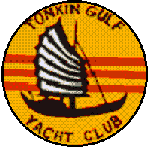
She came under fire on 25 September 1967 from North Vietnamese coastal installations near Dong Hoi, taking one hit; killing one crew member and seriously wounding two others. A month later, on 25 October while patrolling the coast of North Vietnam searching for craft carrying supplies to hostile forces in South Vietnam, she again came under fire for North Vietnam coastal sites. Responding to the attack, she returned fire until the enemy emplacements were silenced. As a result of the clash, naval gunfire missions were implemented under the name Operation Sea Dragon, directing gunfire inland to destroy North Vietnamese supply lines.
Sail with the USS Mansfield DD-728 This Tonkin Gulf Yacht Club site owned by Kman. [ Previous 5 Sites | Previous | Next | Next 5 Sites | Random Site | List Sites ] |
| If you are on Cape Cod and would like to pay your respects to Richard Archer, go here for directions to Oak Neck Cemetery.Please visit Dan “Jake” Jacob’s Tribute Page to shipmate Richard Archer, who was KIA in action in 1967. Thanks, Karl.
A NEW BROWSER WINDOW WILL OPEN. CLOSE IT TO RETURN HERE.  visit the grave of shipmate Richard Archer – 9/12/12 October 4, 2012 I am the Medical Officer who was winched to Mansfield from USS Tripoli’s (LPH-10) SH-34 helo. Mansfields’s company had already prepared MM2 Archer’s remains for transfer, and left me and HM2 Matkowski of Tripoli to triage and treat existing shipboard casualties, and render further medical assistance. All the casualties, other than your KIA, MM2 Archer, who suffered an immediate fatal strike by enemy shrapnel, survived their wounds, and no doubt, served well. Mr. Douglas Gibbon was the Mansfield crewman, who captured me from the helo deck horsecollar, safely physically grasping the Doc, dropped to deck, suffering static induced physical damage from shock, fell to a steel deck from height, shielding me… He denied offer of immediate relief, and returned to his shipboard duties. He was knocked to the deck and suffered damage which might be incipient to helo-to-deck transfer in saline, fuel rich, electrcal, plunging and gaseous environments. I was , with ship’s company and my own airlifted Tripoli corpsman, able to stabilize the medical situation. We and the ship’s corpsmen accomplished this while on gun runs directed by an energetic Commodore, 4 striper, who visually called incoming shore fire and directed evasive maneuvers, while returning fire, having thoughtfully visited sickbay to see the wounded crew and be assured that we could do the necessary surgery while on fast gun runs. When the action was finally complete we were eventually returned to Tripoli by motor whaleboat, the H-34 having become mechanically weary on Tripoli’s flight deck, as helicopters do. The seas that day were moderate, but exciting, with about a four foot height gap between the deck and Mansfield. All except PO2 Archer, survived and returned to duty. Do not forget the deck crew and my corpsmen, and Tripoli and Mansfield corpsmen, and the Tripoli H34 crew and motor whaleboat crew. Good action, well done! Respectfully, |
| 5″ Rounds Fired | 40,001 |
| Days on Gun Line | 220 |
| Times Under Hostile Fire | 8 |
| Enemy KIA | 187 |
| Active Artillery Sites Silenced | 30 |
| Secondary Explosions | 59 |
| Structures/Bunkers Destroyed | 495 |
| Ships/Junks/Boats Sunk | 224 |
Newspaper articles from this time period courtesy of shipmate Jim Frazier.
Awards Ceremony Program courtesy of shipmate ETN2 J.J. Marold.
| From the ship’s log, January 1, 1967 as entered by LTJG Mulvey:”Moored as before in company of four. Starboard side to the USS Blue. Mooring lines doubled the ship snug uptight, nothing will part us on this cold New Years night. The Hector is providing the services we’re requiring as SOPA, COMDESRON nine remains so supine. The Harbor is teeming with ships of all Nations gathered together for rejoicing and celebration. The Hector, the Blue, the Osborn, the Dehaven, moored about us in reconciliation. The New Year promotes it’s hopes and its fears, typical is Vietnam a valley of tears. The year may look gray but in the Navy we say, peace through power will brighten the way. So goodbye to the old year, hail to the new one the Mansfield steams on to insure its a smooth one.” – [Submitted by Cef Suarez 3.9.10] |
 From 1967 to mid-1968, she carried out air-sea rescue, blockade and gunfire support missions in support of Allied operations in Vietnam. In June 1968, MANSFIELD returned to the United States for two years, home porting in Long Beach.
From 1967 to mid-1968, she carried out air-sea rescue, blockade and gunfire support missions in support of Allied operations in Vietnam. In June 1968, MANSFIELD returned to the United States for two years, home porting in Long Beach.
She served as a training recovery ship for NASA’s Apollo missions off the west coast prior to October 1968, when she underwent overhaul at the Naval Shipyard, until January 1969. following training exercised on the west coast, she deployed 26 September to the Far East and home ported in Yokosuka, where she operated in the Sea of Japan as a picket, and participated in gunfire support missions off the coast of Vietnam during November 1969.
Following a five day replenishment at Subic Bay, on 3 January 1970, MANSFIELD deployed to Hong Kong. From 22 January to 8 February, she provided gunfire support for the 1st and III Corps in South Vietnam. Following a short stay at Sasebo, she departed the Far East for the last time returning to Long Beach, 1 April 1970.

Photo courtesy of Greg Bollman. For more go here
The material condition of the U.S. Navy was declining visibly. Funds normally allocated to new ship construction, maintenance, and overhaul went instead to fighting the war in Vietnam. On 1 July 1970, Chief of Naval Operations, Admiral Elmo R. Zumwalt, Jr. emphasized his deep concern about “the accelerating obsolescence of the Navy.” He noted that during Korea and Vietnam, too many of the Navy’s “sea control forces and ships were allocated to obsolesce and , finally, retire with replacement.”
Such was the fate of the MANSFIELD. Relegated to obsolescence and naval cost reallocations, she spent the remainder of 1970 in restricted availability at the Long Beach Naval Shipyard.
The 27-year Navy veteran, made a final short coastal cruise as a Navy warship from Long Beach to San Diego, where she was decommissioned 4 February 1971. During the years of her active duty she received five battle stars for World War-II service, three for Korea and three for Vietnam.
MANSFIELD was disposed and sold to Argentina 4 June 1974. Recommissioned in Argentina as Espora (D31), and decommissioned again in 1978. It was reported, she was mothballed, in desperate need of repair in Puerto Belgrano, Argentina Naval Base near Bahia Blanca; scavenged for spare parts and eventually cut up for scrap in the late 1980’s.
| I received this message from Santiago L. Aversa. He has a website called the “Unofficial Site of Armada Argentina”. As you will see, his version of the Mansfield’s Argentine voyage is quite different than what is here. I hope I can find more information. [Karl 2.14.2000]
“DD-728 never entered active service in the Argentinean navy. She was towed by the tug “Alferez Sobral” and used for parts for the Fletcher, Gearing and Sumner class DD’s that were bought in 1971-72. USS Collet, acquired along with DD 728 was not canibalized and entered service in 1977 as ARA Piedra Buena (D-29). ARA Espora was the former USS Dortch, transferred in 1962. She took part in the blockade against Cuba in the missile crisis. Now the Espora name is carried by a locally built, German designed FFG, namely P-41. the “new” ARA Espora was the lead ship of the class.” |
| THE OFFICIAL ARGENTINE NAVY FACTS ON THE DISPOSITION OF THE USS MANSFIELD DD-728“I RECEIVED THIS LETTER ON 4.25.00. A TRANSLATION IS LISTED DIRECTLY UNDER THE LETTER. THANKS TO SANTIAGO AVERSA AND TONY ARISTY FOR THEIR HELP.” |
|---|
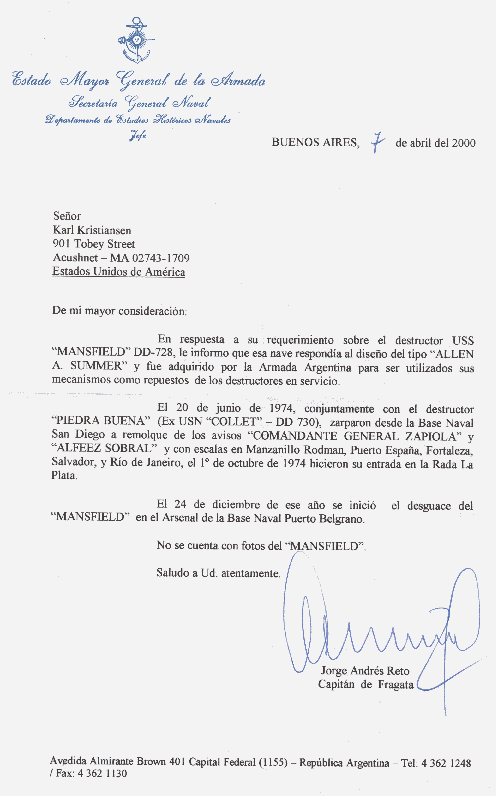
Translation: Navy General Headquarters Buenos Aires, April 7th, 2000 In answer to your request about the destroyer USS “MANSFIELD” DD-728, I inform you that that ship belonged to the “ALLEN A. SUMNER” design and was acquired by the Argentinean Navy in order to use her machinery as spare parts for our destroyers in service. On June 20, 1974, along with the destroyer “PIEDRA BUENA” (Ex USN “COLLET” – DD 730), they left from the San Diego Naval Base under tow by the “COMANDANTE GENERA ZAPIOLA” and “ALFEREZ SOBRAL” (tugs). Making stop-overs at Manzanillo Rodman, Puerto España, Fortaleza, Salvador and Rio de Janeiro. On On December 24 of the same year (1974)the “MANSFIELD” dismantling started at the Naval Base in Puerto Belgrano. We do not have photos of the “MANSFIELD” on file. Salute and Sincerely yours, |
The Collett also, was disposed and sold to Argentina where she participated in the 1982 War and served until the mid 1980’s [ Thanks to Santiago L. Aversa for the additional info ]:Swenson, to Taiwan 6 May 1974, for spare parts. DeHaven, was sold to Republic of Korea Navy, 5 December 1973. She was recommissioned IN CHEON (DD98), and later reclassified as INCHON (DD918). DeHaven is the last remnant of Desron9, and remains in service with the ROK Navy 1994.

Circa 1979, at Puente N. Avellaneda Outside Buenos Aires, Argentina.
Photos courtesy of: Horacio Héctor Virardi
Quilmes, October 15, 2009.
Dear Mr. Kristiansen,
I was born in Buenos Aires in 1957, my ancestors were Italian and Spanish. In 1976 y 1977 I presented my request to join in the Naval Military School, our Annápolis, in 1976 made the exmination and I didn´t approve algebra in the next year approve all, but I can´t enter because the school had capacity for 220 students, and I was the 221, and due to my age I could not serve one third time. But as I told you, I love the warships and visited them every time I could.
I live in Quilmes, a city in the southeast of Buenos Aires Province. In those days I worked in downtown, every morning I crossed the bridge Nicolás Avellaneda, and one day in the year 1979, at the end of June or beginning of July, I saw three ships in the Riachuelo, recongnized them immediately as an LST, two destroyers, one Fletcher with the #21 on her hull and an Allen Sumner unknown. Those ships were moored in the south side of Riachuelo, the LST with her hull against the pier and her bow pointing to the East, in the middle the unknown, ponting to the West and on the outside line the Fletcher pointing to the East. The LST was B.D.T. # 6 Cabo San Isidro, ex L.S.T. #919. The Fletcher with the #21 was A.R.A. Espora (U.S.S. Dortch DD 670). Tomás Espora was one of ours greatest naval heroes in XIX century. I asked the Keeper the name of the unknown destroyer and he told me. “…Oh, that one was the Mansfield…”
The first day I took photos from the north side of Riachuelo, a few days later , with my wife Tina and my friend Ricardo Fuchs, we requested authorization from the Keeper to take photos and to visit the ships. Those photos were taken with an Instamatic Kodak so they aren´t professional because I wasn’t an expert. The next week began the work with the blowtorch and I saw them disappear a little every day. Sad end for ships with a great combat history, so these photos are the last taken while they were still afloat. In my country no one of the Fletchers, Allen Sumner or Gearing, are left like a museum.
Horacio Héctor Virardi
Beruti # 2830 – 1879 Quilmes
Pcia. de Buenos Aires.
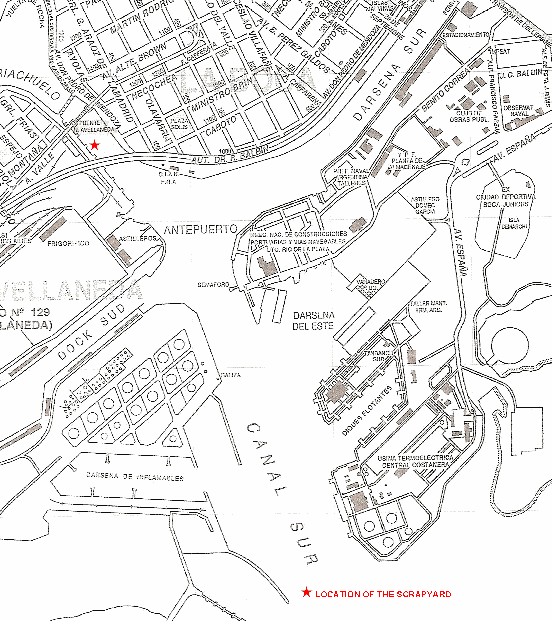
Riachuelo is the natural border between Federal Capital and Buenos Aires Province, The nearest área in Capital is named La Boca, actually tourist place for the connection with the Tango (Caminito Street) and Football Boca Juniors Stadium.
DISCLAIMER: This text is, I believe, accurately copied verbatim from the originals. It surely was never proof read. The number of the Lexington in the Mansfield Story is not right but that’s the way it came. DICK HERRINGTON RM3 58/61
| U. S. S. MANSFIELD (DD728) DEPLOYMENT STORYU. S. S. MANSFIELD left Long Beach, California for WESTPAC on 17 July 1959 under the command of Commander B. D. Gaw, U. S. Navy and with COMDESRON NINE, Captain C. M. HENDERSON, U. S. Navy embarked.
Enroute to WESTPAC, MANSFIELD had a two day stopover at Pearl Harbor where the first of the DESDIV 91 softball competition was begun. This inter-divisional spirit displayed itself throughout the cruise as the four hour Midway fuel saw two games played. DD-728 steamed happily into Yokosuka, Japan on 4 August, looking forward to voyage repairs and availability alongside U.S.S. PRAIRIE (AD-15) and recreation in the nearby cities of Yokohoma, Kamakura and Tokyo. Upon completion of the availability, MANSFIELD left for the Philippines area for TG 77 Fast Carrier Task Force operations with U.S.S. HANCOCK (CVA19) and U.S.S. LEXINGTON (CVA34). It was during these operations that MANSFIELD received notification of the Green “E” award for excellence in Operations and Communications and proudly (and promptly) displayed the coveted Green “E” on all Operations Department spaces. Shortly following this period of operations, U.S.S. MANSFIELD with DESDIV 91 steamed into Subic Bay for 7 days availability at Ships Repair Facility Subic to put her back into shape for the forthcoming Formosa Straits operation with TF 72. During our Subic stay, President Eisenhower’s people-to-people program received a boost when this ship’s Recreation Counsel conceived the idea of painting the St. Joseph’s mission in nearby Olongapo. The idea caught hod with the entire body of officers and crew, and before it was done, a 21 room school had the inside completely painted and a new set of athletic equipment was donated to the school. In a party given by St. Joseph’s for the painting participants, the nine year old mistress of ceremonies said, “Welcome officers and crew of U.S.S. MANSFIELD, the greatest ship in the U.S. Navy”. Also during our Subic trip a DESDIV 91 Olympiad was held featuring softball, basketball, volleyball, arm wrestling, and track, which boosted spirits despite the Philippine heat. Side trips of wild boar hunting were also popular with the crew – if somewhat unpopular with the wild boars. Our stay ended in Subic Bay, MANSFIELD left for the Formosa Straits to join TF 72. During our stay in the Straits area, much training was accomplished in all departments and ship visited Kaohsiung, Taiwan and Hong Kong. Hong Kong was the paradise for Christmas shoppers, sightseers, camera bugs, and clothes houses: and ended 7 days later with the billfolds depleted and a very contented crew. MANSFIELD rejoined TF 72 for two more weeks operations before being relieved on October 30th. U.S.S. MANSFIELD (DD728) then headed north for Sasebo and a week’s voyage repairs and final liberty before heading for CONUS. DD-728 will arrive in Long Beach on Thanksgiving Day, having fulfilled her part of the SEVENTH Fleet Mission. She will return as a completely trained and ready unit, ready to assist whenever and wherever she is needed, and ready to do her part and more if asked. |
| DESDIV 91 DEPLOYMENT STORYDESDIV 91 backed away from pier seven, Long Beach, amid the final farewells of wives, children, parents and friends to begin another deployment to the Western Pacific. Although many hearts were saddened by the prospect of the months to be spent away from loved ones, all were looking forward to the challenge of operating as a part of the “first team”, the mighty Seventh Fleet.
Excitement was not long in coming upon DESDIV91. Three days out of Long Beach am emergency message was received from a USNS ship, the MAUMEE, that a crew member was suffering from what seemed to be acute appendicitis and no doctor was on board. Captain C. M. HENDERSON, COMDESRON NINE, immediately dispatched USS BENNER with Dr. R. E. MILLER aboard to assist. Arriving on the scene, Dr. MILLER took the situation in hand, The patient’s symptoms were relieved and the MAUMEE was able to proceed to port with the patient reasonably comfortable. A good portion to the crossing was devoted to routine drills to “sharpen” the various departments on the ship and keep an edge on the talents that quickly slip away if not practiced. DESDIV 91 arrived in Yokosuka, Japan on 4 August for an arrival availability alongside USS PRAIRIE, COMDESFLOT ONE’s flagship. all ships took advantage of the time to accomplish necessary repair work and to fill the shopping lists that all married men and most single men bring to Japan. Departing Yokosuka, DESDIV91 took advantage of the availability of USS BREAM (SS243) for several days of antisubmarine warfare training. After this they joined with USS LEXINGTON (CVA16) to operate as a portion of a fast carrier task group. The task group joined with other units of SEVENTH FLEET for a combined air defense and striking exercise nick-named “TALL DOG”. With “TALL DOG” successfully completed, the division headed for Subic Bay and another repair period, however, increasing tension in the Eastern portion of the globe made it necessary for DESDIV 91 to forego the opportunities for repairs and return to sea with USS HANCOCK (CVA19) as part of another carrier task group. After a short period of operations DESDIV 91 was allowed to return to Subic Bay and a well deserved availability alongside USS FRONTIER. While in Subic the Uss MANSFIELD, flagship of COMDESRON NINE, was notified that she had been awarded the green “E” for excellence in operations for the year ending 30 July 1959. The division held what is know as the DESDIV 91 Olympiad, a series of athletic events between the ships of the division. The winner and holder of the division trophy for the year was USS DE HAVEN. MANSFIELD and DE HAVEN also scored heavily in the area of human relations while there. DE HAVEN repainted the inside of the Protestant Mission Church in Olongapo. The MANSFIELD, under the able direction of LTJG W. H. SHOWERS, completely repainted the inside of the Catholic Mission School. On the last day of the ship’s stay in stay in Subic a program of appreciation was given by the teachers and students of St. Josephs Catholic Mission School for the MANSFIELD. All hands were sure it was a worthwhile job when a little sixth grade girl introduced the program with these words: “Welcome officers and men of the USS MANSFIELD, the greatest ship in the U. S. Navy”. From Subic Bay DESDIV91 proceeded to Kaohsiung, Formosa to take a turn as watchdogs on the outermost frontier of freedom, the Formosa Patrol. Though the duty is monotonous and certainly not the exciting life most would picture, it is a necessary function of a destroyers existence and serves to illustrate one of the many functions that a destroyer can reasonably perform. While serving as part of the patrol each ship was given time off for a trip to Hong Kong, one of the most interesting and exotic cities of the East where East meets West and just about any other section of the world. Having completed duty with Task Force 72, the division went to Sasebo, Japan for a final availability and then back to Long Beach – Thanksgiving was more meaningful for many this year than usual. The destroyers of DESDIV 91 ran the gamut from ASW to carrier operations to the routine of patrol. All of these functions are only part of a days work for these destroyers and their able crews. If one name could be given them we would say “Thy name is versatility”. |
| This letter is an actual verbatim copy of the original |
|---|
|
U.S.S. mANSFIELD (DD-728) Dear Friend: As MANSFIELD’s 1959 Far east cruise draws to a close and we steam happily towards Long Beach and our homes, I thought that this would be an appropriate time to acquaint you with our course of events during the past few months. To this end, I am enclosing th deployment story of MANSFIELD and that of Destroyer Division 91, the division to which MANSFIELD is attached: also, a photograph of the U.S.S. MANSFIELD (DD-728), the ship on which your Navy man proudly serves. It is hoped that these stories will give you a better understanding of the U.S. Navy’s and MANSFIELD’s position and function in the Far East. It has not been an overly long cruise, and the crew of U.S.S. MANSFIELD (DD-728) has had the opportunity to see many interesting and new places. We have enjoyed our association together and the realization that we are doing a job for our country. But we look forward to a long period in the States, during which time each and every one of us will have ample time to see our loved ones. In closing, I should like to take this opportunity to convey my very bes wishes to you for the holiday seasons that lie ahead. Sincerly, |
Photo courtesy of GMG3 Bill Dunn (66-68)
Story courtesy of Capt. Jack R. Griffin

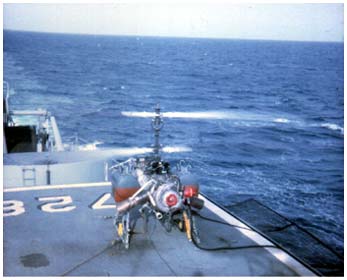
“A few days ago Tom Harper sent me a copy of a photo (shown above, along with another) of a Snoopy configured DASH and some old memories stirred. One of these is amazing, but first I must point out that in 67-68 Bob Kesteloot, John Tortorici, Dick Couch and I discussed our Snoopy ops to such a degree that it isn’t clear whose idea was whose. Surely, others in the crew had input; but if fair to name them, I must leave that to Bob, John, and Dick to clarify.”
“There were two configurations beyond the original intent for the Dash. One was called Midget. The purpose of this configuration was the rescue of downed pilots in areas unsafe to send a manned helo. The second was Snoopy. Although a mission of Recon is generally associated with this configuration, it was as a naval gunfire spotting platform that was the priority. This was prompted by the pending removal of the A1 Spad as the platform for airborne spotting.”
“The first use to which we put our DASH was as Midget. We were assigned as shotgun for the Reeves, DESRON 9 flagship, on South SAR. A plane of ours had been shotdown and the two people in it had successfully ejected. One person was on the beach and the other in the surf firing tracers from his pistol. The Reeves helo was unable to close because of gunfire from the treeline. After awhile, aircraft overflying our men reported the one on the beach to be captured by 2-3 men while one VC covered our man in the water. The enemy took our guy’s pistol, slung his AK ,and used the pistol to control our man. Each time one of our planes flew over, the VC would duck under the water. After a couple of flyovers it occurred to the “good guy” that he was being restrained with an empty gun because he had fired all his ammo. So, what did he do? Well, on a final flyover, he reached in his jumpsuit and pulled out another gun and either clubbed the enemy with it or shot him. (I don’t remember which.) Then he started swimming to sea for all he was worth. We sent in Midget. Midget had a jungle penetrator hanging from it, and the intent was to drag it in the water slowly past the downed pilot expecting him to grab on and then be flown out to safety. A couple of close passes were made, but never grabbed. Eventually, the Reeves’ helo was in position to pick up our man safely and did so. To the best of my knowledge, this was the only time Midget was attempted to be used in combat. The flyer was awarded the Silver Star.”
“That isn’t quite the end of the story. I always admired our man’s escape. I met him by chance many years later. In my final tour of duty I was the Director of Quality Assurance for the Defense Contracts Administration Services Region–Los Angeles. On a visit to one of my ordnance contractors in San Ana in 1980, I exchanged pleasant conversation with one of my in-house QA inspectors. It took a surprisingly short time for me to discover that this fellow was our man who got away. I was awed by this opportunity to meet him and discuss that day. Unfortunately, his escape had so infuriated the enemy that it is suspected the enemy killed our other man in revenge. Although observed going into the trees under guard, he did not make it to any POW camp. Our hero sadly blamed himself for his friend’s apparent death.”
“Bob, John, Dick or I got the idea to hang a bomb rack on Snoopy so that it could carry a 500 lb. bomb on one side and a video camera on the other. Dick and his gang got the bomb rack somehow, but despite my several personal attempts, I was not able to get permission to use it. Our idea was to put Snoopy into a hover directed over the most threatening gun sites such as on Hon Mat and Hon Me islands and drop the bomb. Our Admiral nixed the concept with instructions that he wanted us to concentrate solely on developing a capability to spot with Snoopy. The resolution attainable at the time was insufficient and eventually the idea was abandoned. I thought our idea would have worked fine and was disappointed we never had a chance to prove it.”
Jack R. Griffin
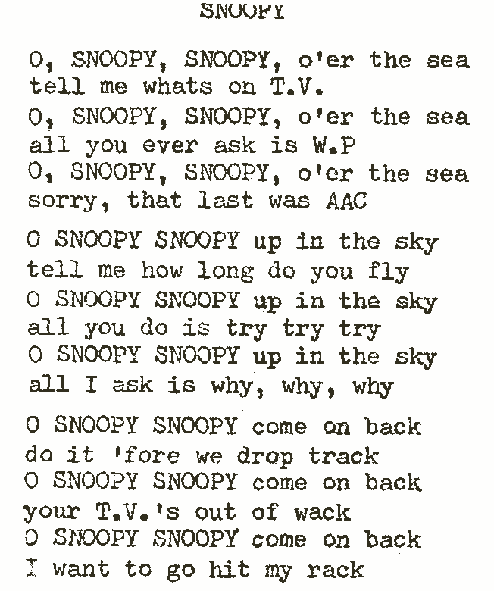
Gravesite of Richard Archer


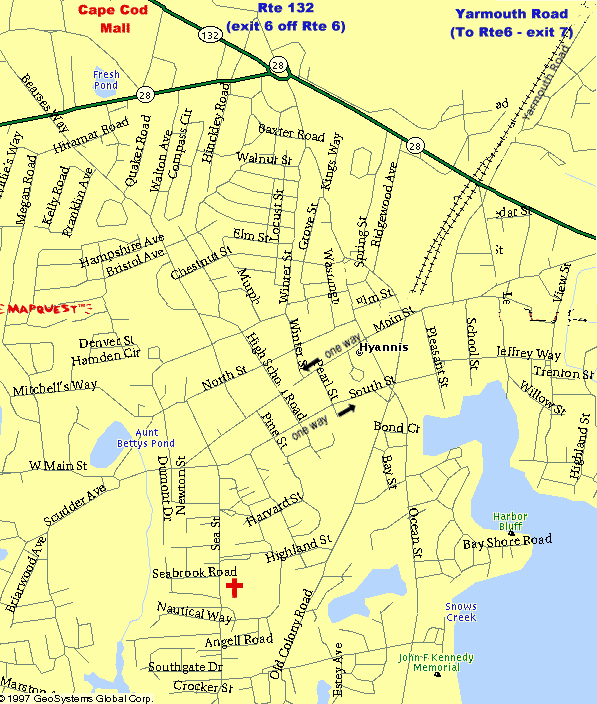
Coming down the Mid-Cape Highway (Rte.6) get off at Exit #6, Rte. 132. Stay on 132 for about a mile and take a right onto Bearse’s Way. Take this into Hyannis to Main St. Turn right at the lights, go to the next set of lights and turn left onto Sea St. Go down Sea St. for about half mile; Oak Grove cemetery is on the left. Go thru to the back of this cemetery and Oak Neck is on the backside across OakNeck Rd.
You can also get to it off Old Colony Ave, about a mile down South St. You can see this intersection on this map.
Thanks for Shipmate ETN2 J.J. Marold for sending a copy of the Awards Ceremony progam.
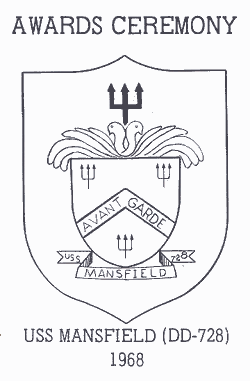
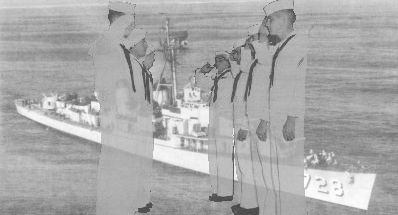
Thanks to shipmate Jim Frazier for this copy of the Official Navy Welcome Aboard booklet (circa 1962)
For a complete list of Commissioned Crew Members go here .
WELCOME ABOARD
Whether you have come aboard for an afternoon visit or for a four-year hitch, you are probably very interested in the what, when, and where of the USS Mansfield. With a short tour and a little exercise of the imagination you can turn the next half-hour into an enlightening experience and as adventure into history.
Start in the ‘midships passageway and you start at the beginning of the Mansfield story. Read the bronze plaque on the after bulkhead:
|
U.S.S. MANSFIELD (DD-728) NAMED IN HONOR OF SERGEANT DUNCAN MANSFIELD, U.S. MARINE CORPS (DECEASED), WHO VOLUNTEERED AND TOOK PART IN THE EXPEDITION UNDER LIEUTENANT STEPHAN DECATUR, JR, U.S. NAVY COMMANDING THE U.S. KETCH “INTREPID” WHICH ENTERED TRIPOLI HARBOR ON 16 FEBRUARY 1804, AND DESTROYED THE FORMER U.S. FRIGATE “PHILADELPHIA”, WHICH HAD BEEN CAPTURED. KEEL LAID – 28 AUGUST 1943 AT BATH IRON WORKS, BATH, MAINE. LAUNCHED – 29 JANUARY 1944. COMMISSIONED – 14 APRIL 1944 AT BOSTON NAVY YARD, BOSTON, MASS. COMMANDING OFFICERS CDR. ROBERT E. BRADDY JR, USN – 14 APR. 1944 TO 1 FEB. 1945 THANKS TO HTC RON REEVES DD-847/DD-822 FOR THE ADDITIONAL NAMES |
Immediately after her shake-down cruise off the East Coast, Mansfield joined the Pacific Fleet for the great naval offensive which was to strike Imperial Japan to her knees. But her first engagement was to be with another worthy foe.
As you step forward along the main deck, starboard side, stop for a moment to look back over the deckhouse and superstructure. Picture, if you can, the insignificance of a destroyer in the jaws of a raging sea. On the evening of 17 December 1944, without power and light, with superstructure wrenched and torn, and her after stack lost over the side, Mansfield was still afloat after one of the most disastrous storms in the history of the U.S. Navy. On that December morning while steaming with Admiral Halsey’s 3rd Fleet enroute for a strike against enemy held Luzon, Mansfield and other fleet units were struck by a devastating typhoon. Winds shrieked at 93 knots; gigantic mountains of water thundered over the harassed ships. The typhoon flailed her victims with all nature’s malevolent forces for three days, and when the howl of the winds finally died, the 3rd Fleet counted a toll of 790 men, 200 planes, and 3 destroyers lost. Mansfield was indeed fortunate to have survived the storm.
Move forward now along the main deck and pass through the spray shield onto the forecastle. Here you see two of the three twin 5″ 38-calibre gun mounts which are the ship’s major armament, second in importance only to the anti-submarine warfare weapons. Before her conversion, the orange flames and ringing blasts spit from Mansfield’s 5″ guns signalled the violent destruction of enemy shipping, aircraft and shore defenses.
On the morning of 13 September, 1950, leading five other destroyers, including the Collett, DeHaven and Swenson of Destroyer Division 91, Mansfield steamed past the heavily fortified island of Wolmi-Do, through the Flying Fish Channel, and into Inchon Harbor – Communist North Korean held territory.
U.N. forces were about to launch the great Inchon landing assault that was to open the second front in Korea and provide a pincer force on the peninsula. Enemy forces were know to be well dug-in, but intelligence could not accurately locate the seaward facing gun emplacements. The emplacements had to be neutralized before a successful landing could be made.
In broad daylight Destroyer Division 91 brazenly anchored in the harbor and dared the shore batteries to fire. The affront was soon answered and as the Communist guns revealed themselves, destroyer 5″ shells followed the tell-tale flashes and smoke puffs to knock out, one after another, the opposing batteries.
On the following day the division returned again to bait the enemy and destroy his defenses. Then on the 15th, Mansfield led the entire invasion fleet in for the successful landing and subsequent drive to the Yalu River.
For this action Destroyer Division 91 was presented the Navy Unit Commendation and, unofficially, became know as the “Sitting Duck Division.” Mansfield’s Captain, Commander Headland, was cited with the Silver Star, and six other officers and men received the Bronze Star and commendation ribbon with the combat “V”.
Now walk to the port side of Mount 51 on the main deck and look for the figure “30” in raised welded bead in the waterway along the side of the ship. this figure marks the location of frame 30, one of the transverse structural members of the ship’s hull. from that frame forward Mansfield’s bow is a borrowed one, welded on after the original was reduced to twisted, mangled scrap in September 1950.
On the 26th of September, Mansfield in company with the USS Swenson departed Sasebo, Japan, to carry out night interdiction fire against coastal highway traffic near the 38th parallel. for three nights Mansfield and Swenson steamed along the darkened coast blasting truck convoys and blockading the major coastal highway so necessary to the North Korean withdrawal.
About 1230 on the fateful 30th, an urgent dispatch directed the ships to proceed at best possible speed to latitude 38° 45′ North, longitude 128° 15′ East to assist a B-26 aircraft reported down at that point. At 1500, with Swenson lying to outside the 50-fathom curve to cover the approach, and a B-17 search-and-rescue plane overhead, Mansfield began to edge into the area of the reported wreckage. As the ship slowly closed the area machine gun and rifle fire arced toward the B-17 from installations on Tie To Island, 500 yards to the west. the ship stopped as lookouts combed the area for indications of the downed plane.
Suddenly, with an ear-splitting blast, a high order explosion ripped the drifting ship as a geyser of water spewed up on the port side to the height of the gun director above the bridge. the ship had struck a mine. While repair parties rushed to the scene, the Captain backed engines full and maneuvered the ship stern first through the waters through which she had entered. Fast, sure work by the repair parties stopped the flooding and shored the crumbled bulkheads and decks before the damage to the ship was out of control.
When final muster results were reported Mansfield had suffered 27 wounded, but had lost no except the ship’s dog, “Pohang,” who was not found after the explosion. For their heroic work in saving the ship, six of the ship’s officers and men received medals ranging from the Silver Star and the Navy and Marine corps medal to the Bronze Star. Perhaps it is only a sailor’s superstition, but the ship has never since had a mascot.
Walk aft now past the ship’s bell, used to announce the hours of the watch, and along the deckhouse through the port side spray shield door. Step through the first door to your left and climb the inclined ladder in the passageway to the 01 deck (first deck above the main or 1st deck). A few more steps aft, then climb again to the 02 deck and take the first door opening to your left.
You are now in CIC (Combat Information Center). As your eyes grow accustomed to the dark-necessary to allow the radar operations to see the phosphorescent display on their scopes-look about you at the status boards, radar consoles and repeaters, radio telephones and other information gathering and display equipment. CIC is the nerve center of the ship. All the information gained from the ship’s many, advanced, radar search, communications, navigational, electronic countermeasures, and attack systems is collected, displayed and evaluated here. recommendations based on the strategic and tactical situation unfolding are passed to the bridge for action by the Commanding Officer.
Aft on the starboard side is the entrance to Sonar Control. “Sonar,” derived from the words “sound navigation and ranging,” is an underwater search system which operates on the principle that a sound beam traveling out under water will bounce back or “echo” when it strikes an object in the water.
The complex instruments you see around you do no more than translate that echo into ranges and bearings, courses and speeds of underwater contacts. This is Mansfield’s primary anti-submarine search system. Watch the “stack” for a moment if it is operating. See and hear the sound wave as it radiates outward, then listen for the ping of a contact as it shows on the “stack” as a bright pip.
Leave Sonar Control by the starboard door to the weather decks, and walk forward to the Pilot House and Open bridge. Before you step into the Pilot House, look up at the mast where, very likely, you will see the radar antennas rotating, transmitting and receiving the signals you saw displayed on the scopes in CIC.
The Pilot House and Open Bridge are the Captain’s command directions post. It is here that the final battle decisions are mane and the final orders given. Mansfield’s Captains stood on this bridge through every major Pacific campaign from the World War II invasion of Leyte through the concluding assault on Japan and limited war in Korea. Look down from the bridge now where Mansfield officers and men guided the Iwo Jima and Okinawa campaigns, shooting down four fanatic ally attacking planes, rescuing six downed aviators and destroying 13 murderous mines; incredibly coming out unscathed while the fleet suffered carnage unparalleled in naval history. Stand on the bridge wings where Captain Smythe in July 1945 directed a high speed raid on Japanese merchant shipping off the coast of Japan-sinking two freighters and damaging two more. Fell the excitement and tension in the air when Mansfield in company with the USS Blue captured the Japanese submarine I-400 during the final phases of the Pacific war. Sense the forebodings of the cold war as officers and men watched from the Mansfield’s Formosa convoy escort position some 55,000 Communist Chinese shells poured into the Islands of Quemoy and Matsu during 24-hour period in September 1958.
Before you leave the Pilot House, take a turn at the wheel and examine the engine order telegraph by means of which the Officer of the Deck’s orders are relayed to the enginrooms in the bowels of the ship. Notice the number of telephones necessary to communicate with control centers throughout the ship and with other ships and aircraft.
Now step past the Navigator’s chart desk out through the port Pilot House door onto the Bridge and walk aft and down the inclined ladder by the forward stack to the Torpedo Deck. the torpedo tubes angled menacingly outward and stacked in triple mounts project the ship’s deadly anti-submarine homing torpedoes into the water, where, using their own sonar, they unerringly seek out and destroy the killer lurking below.
Abaft the after stack are the Torpedo Stowage and the Drone Hangar. Go past the ship’s boat on the port side through the door into the Hangar.
In the Drone Hangar and on the Flight Deck aft of the DASH drone is serviced and launched as a vital part of the ship’s anti-submarine weapons system. DASH, Drone Anti-Submarine Helicopter, is an unmanned , remote-controlled helo capable of carrying homing torpedoes to submarine contact areas will outside the ship’s danger perimeter. Controlled from a “black box” in Sonar Control, DASH extends the ship’s offensive capability far beyond previous systems with correspondingly less danger from counter torpedo attacks.
From the Flight Deck double back through the Hangar and across the Torpedo Deck to the door below the port inclined ladder to the 02 deck (the ladder you previously descended). walk forward through the passageway until you come to the door on your left leading out to the weather decks. Step outside and descend the inclined ladder to the main deck, then turn forward and once again enter the deckhouse through the door just aft of the spray shield (as you did when on your way to CIC). this time walk aft in the passageway past the inclined ladder up, and , instead, take the ladder below it down to the Messdecks.
The two Hedgehog projectors are installed on this deck to provide optimum conditions for close-in attack. Hedgehogs are anti-submarine “ahead-thrown-weapons” which are fired in circular patterns several hundred yards ahead of the ship by the two projectors on either side of the deckhouse. As the charges sink through the water they are exploded by contact with the submarine. It takes only one! Walk around the deck past 5″/38-calibre Mound 52. Note the practice hedgehogs used for loading practice, alike in every way except warhead to the actual charges, leave the 01 deck by way of the inclined ladder on the port side and walk aft along the main deck past the deck-mounted boat winch and under the ship’s boat.
All the way aft, on the fantail, is located the ship’s latest equipment installation: the VDS of Variable Depth Sonar, developed to spy into the naturally occurring refuge of the submarine. The ocean is crossed by innumerable subsurface currents which cause varying temperature water layers to be formed at unpredictable depths. Because sound travels at different speeds through water at different temperatures, a sonar sound beam may be refracted or “bent” in a entirely different direction as it passes through the “layer,”, thus completely missing the submarine hiding just below. VDS puts the searching back on the sub. The sound transmitter, you see, is lowered hundreds of feet beneath the ship to a depth below the thermal layer. The display projected by this undistorted sound beam is reproduced in Sonar Control with resulting vastly increased accuracy and effectiveness in anti-submarine warfare capability.
You have just completed a brief tour of the ship which we hope has given you a picture of the Mansfield in action. She is a “fast ship” which has gone in “harm’s way” often and emerged victorious and distinguished.
Mansfield’s past is a matter of record. You can read it in her service ribbons mounted below the bridge. From left to right, top to bottom:

- Navy Unit Commendation
- China Service Medal
- American Campaign Medal
- Asiatic-Pacific Area Campaign Medal
1 Star – Luzon Attacks [5-6, 13-14, 19-22 Nov, 14-16 Dec 1944
1 Star – Luzon Operations- Formosa Attacks 3-4, 9, 15, 21 Jan 1945
- Luzon Attacks 6-7 Jan 1945
- China Coast Attack 12-16 Jan 1945
- Nansei Shoto Attack 22 Jan 1945
1 Star – Iwo Jima Operation 15 Feb-4 Mar 1945
1 Star – Okinawa Gunto Operation 17 Mar-11 June 1945
1 Star – 3rd Fleet Operations against Japan 10 Jul-15 Aug 1945 - Victory Medal, World War II
- Navy Occupation Service Medal
- National Defense Service Medal
- Korean Service Medal
1 Star – North Korean Aggression 27 Jun-12 Sep, 18-30 Sep 1950
1 Star – Inchon Landing 13-17 Sep 1950
1 Star – U.N. Summer-Fall Offensive 18 Jul-8 Aug, 19 Sep-2 Nov, 3-14 Nov 1951
1 Star – 2nd Korean Winter 11 Dec 1951-25 Jan 1952 - U.N. Service Medal
- Philippine Liberation Ribbon
- Syngman Rhee Unit Citation
Mansfield’s future is the future of the officers and men aboard her. She has established her worth in the past and stands ready to prove herself anew should the occasion arise. We hope that this short tour has been able to impart to you a little of her fine traditions as well as a better understanding of her capabilities as a man-of-war and a member of our defense team.
As you leave the fantail where our National Ensign proudly flies in port we hope that you will share with us the pride we feel in serving aboard a worth representative of the undisputedly most powerful Navy of all time-dedicated to guarding and preserving the freedom of free nations all over the world.
–USN–
| UNIT AWARDS AND CAMPAIGN PARTICIPATION | |||
| AWARD | START DATE | END DATE | REMARKS |
| AE – ARMED FORCES EXPEDITIONARY MEDAL | 30-AUG-1958 | H: Taiwan Straits (23 Aug 50 – 1 Jun 63) | |
| AE | 04-SEP-1958 | 19-SEP-1958 | H |
| AE | 16-OCT-1958 | H | |
| AE | 29-SEP-1959 | 30-0CT-1959 | G: Quemcy-Matsu (23 Jul 58 – 1 Jun 63) |
| AE | 25-JAN-1962 | 26-JAN-1962 | I: Vietnam (1 Jul 58 – 3 Jul 65) |
| AE | 16-JUL-1962 | G | |
| AE | 30-OCT-1969 | J: Korea (1 Oct 66 – Jun 74) | |
| AE | 22-FEB-1970 | 25-FEB-1970 | J |
| CR – COMBAT ACTION RIBBON | 25-OCT-1966 | ||
| CR | 18-MAY-1967 | ||
| CR | 04-JUL-1967 | ||
| CR | 25-SEP-1967 | ||
| CR | 11-APR-1968 | ||
| NU – NAVY UNIT COMMENDATION | 13-SEP-1950 | 15-SEP-1950 | |
| NU | 15-JUL-1966 | 26-JUL-1968 | |
| RG – REPUBLIC OF VIETNAM MERITORIOUS UNIT CITATION (Gallantry Cross Medal Color with Palm) |
17-MAY-1967 | 19-MAY-1967 | |
| RG | 13-NOV-1967 | 20-NOV-1967 | |
| RG | 08-DEC-1967 | 13-DEC-1967 | |
| RG | 03-FEB-1968 | 09-FEB-1968 | |
| RG | 09-APR-1968 | 16-APR-1968 | |
| VS – VIETNAM SERVICE MEDAL | 10-SEP-1965 | 03-OCT-1965 | |
| VS | 07-OCT-1965 | 09-0CT-1965 | |
| VS | 25-NOV-1965 | 24-DEC-1965 | |
| VS | 07-AUG-1966 | 20-AUG-1966 | |
| VS | 23-OCT-1966 | 20-NOV-1966 | |
| VS | 10-JAN-1967 | 26-JAN-1967 | |
| VS | 06-MAR-1967 | 09-APR-1967 | |
| VS | 11-MAY-1967 | 26-MAY-1967 | |
| VS | 02-JUN-1967 | 22-JUN-1967 | |
| VS | 29-JUN-1967 | 16-JUL-1967 | |
| VS | 19-SEP-1967 | 29-SEP-1967 | |
| VS | 15-OCT-1967 | 29-OCT-1967 | |
| VS | 12-NOV-1967 | 29-NOV-1967 | |
| VS | 03-DEC-1967 | 21-DEC-1967 | |
| VS | 25-JAN-1968 | 02-MAR-1968 | |
| VS | 25-MAR-1968 | 18-APR-1968 | |
| VS | 19-MAY-1968 | 10-JUN-1968 | |
| VS | 24-OCT-1969 | 28-OCT-1969 | |
| VS | 25-NOV-1969 | 28-DEC-1969 | |
| VS | 04-JAN-1970 | 15-JAN-1970 | |
| VS | 21-JAN-1970 | 13-FEB-1970 | |
COMMISSIONED CREW MEMBERS – USS MANSFIELD DD-728 – 14 APRIL 1944
PLANKOWNERS – THOSE PRESENT ON COMMISSIONING DAY
THANKS TO SHIPMATE JOHN ARMSTRONG FOR A COPY OF THIS LIST
Officers – 20
NAME RANK SERVICE DESIGNATION -------------------------------------------------------------------- Braddy Jr., R.E. CDR USN Growler, C.L. ENS USN(T) Wendt, L.R. ENS USN(T) Hearns Jr., G.E. LT USN Mills, L.E. ENS USNR C-V(G) Fleck Jr., L.E. ENS USNR D-V(G) Hellman, R. ENS USNR D-V(G) Utter, D.D. ENS USNR D-V(G) Weaver, J.D. ENS USNR D-V(G) Brown, R.G. LT USNR D-V(G) McCurdy, J.R. LT USNR D-V(G) Riesmeyer, D.W. LT USNR D-V(G) Liberman, E.J. LTJG USNR D-V(G) O'Brien, E.J. LTJG USNR D-V(G) Marx, R.E. ENS USNR DE-V(G) Johnson, R.A. ENS USNR E-V(G) Williams, W.B. LT USNR E-V(G) Wycoff, W.H. LTJG USNR E-V(RS) Thompson, C.H. LTJG USNR MC-V(G) Berkley, R.H. ENS UNSR SC-V(G)
ENLISTED – 339
NAME RATE SERVICE CRUITSTA ------------------------------------------------------------------------- Abney Jr., W.M. SN USNR Little Rock, AR Adams, M.E. FN USN Los Angeles, CA Adcox, R.F. WT3 USN Nashville, TN Adkins, E.H. SA USNR Abingdon, VA Airhart, T.A. SM1 USN Birmington, AL Akers, F.N. FN USNR Indianapolis, IN Albin, J.H. RMC(AA) USN Almond, G.W. SA USNR Richmond, VA Altizer, R.B. BMC(AA) USN Richmond, VA Altomari, C.C. SA USNR Philadelphia, PA Anderson, P.L. WT3 USN Cleveland, OH Anderson, R.O. FN USNR Hartford, CT Ashley, R.L. SA USNR Dallas, TX Attey, D.J. MMC(PA) USN Baker, W.W. SA USNR Chattanooga, TN Barber, W.C. SA USNR Columbia, SC Barnett, C.E. SA USNR Abingdon, VA Barnette Jr., M.M. SA USNR Abingdon, VA Barone, A. SN USNR New York, NY Batts, H.R. EM3 USNR Raleigh, NC Baumgartner, C.L. YN2 USNR Macon, GA Belton, H.W. SA USNR Raliegh, NC Black, W.W. SA USNR Spartanburg, SC Blessing, W.M. SA USNR Harrisburg, PA Bodzioch, A.S. GM3 USNR Baltimore, MD Bonnell, J.O. FN USNR Harrisburg, PA Bourdon, L. MM1 USN Detroit, MI Britt, J.W. BM2 USN Raleigh, NC Brown, F.J. SA USNR Seattle, WA Brown, K.E. FN USNR Brusso, F.R. SA USNR Richmond, VA Burbrink, R.J. MMFN USNR Burden Jr., H. SD2 USNR Columbia, SC Burhans, K.C. SN USNR New York, NY Burke, D.E. RDSA USNR Phoenix, AZ Byrum, W.T. SA USNR Raleigh, NC Caddy, R.E. GMSN USNR Omaha, NE Caldwell, E. SA USNR Chattanooga, TN Campbell, J.A. CS3 USNR Charleston, WV Capperella, H.G. FA USNR Pittsburgh, PA Carpenter, L.J. WTC(PA) USN Springfield, MA Cave, L.M. SO3 USNR San Diego, CA Cerami, A.F. MM2 USNR Philadelphia, PA Cervilla, R. GMC(PA) USN Christensen, R.A. SA USNR Clark, E.E. MM1 USN Chicago, IL Clifton, O.G. GM2 USN Baltimore, MD Cochran, C.L. SA USNR Abingdon, VA Cody, C.S. COX USNR Macon, GA Compel, T.J. SN USN New York, NY Copp, L.E. SA USNR Albany, NY Corn, F.L. SA USNR Raleigh, NC Costello, S. SN USNR New York, NY Cox Jr., H.J. SA USNR Philadelphia, PA Crouse, R.B. TM3 USNR Clarksburg, WV Cryan Jr., R.V. SN USNR Newark, NJ Cucchiaro, F.J. FN USNR New York, NY Cufferi, S.G. SN USNR New York, NY Culp, J.C. SN USNR New York, NY Cummings, R.D. FA USNR Boston, MA Cuttingham, W.H. MMFN USNR New York, NY Cylc, J.J. SA USNR Camden, NY Dale, J.P. BM2 USNR New Orleans, LA Davis, J.L. EN2 USN Brooklyn, NY DeBevoise Jr., J.E. M1c USNR Jacksonville, FL Dec, F.J. FN USNR New York, NY DeFrancisco, A.C. MM3 USN New York, NY DeJacimo, P.A. SN USNR Cleveland, OH DeIgrosso, F.A. GM3 USNR Pittsburgh, PA Devereaux, J.J. SN USNR New York, NY DiBari, G.J. SN USNR New York, NY Donais, T.R. SN USNR Milwaukee, WI Dworkowski, T.L. SN USN Baltimore, MD Earnest, H.S. SA USNR Atlanta, GA Eayrs, S.W. SN USNR Minneapolis, MN Edens, P.E. SN USN Springfield, IL Edwards, G.R. SA USNR Abingdon, VA Ekas, J.P. SA USNR Elswick, J.J. SA USNR Washington, DC Engel, W.H. SN USN New York, NY English, M.G. SN USNR Pittsburgh, PA Evans, D. SN USNR Indianapolis, IN Farley, J.W. SN USNR New York, NY Faulkner, J.E. BM2 USN Fiejdasz, W.J. SN USNR Pittsburgh, PA Fish Jr., T.G. TMC(AA) USN Brooklyn, NY Flick, P.L. YN1 USNR Erie, PA Fraunholtz, E.R. SA USNR Greenburg, PA Freeman, F.J. SN USNR Abingdon, VA Friedman, M.S. SN USNR New York, NY Frye, L.A. SA USNR Springfield, MA Gabriel, R.C. FA USNR Toledo, OH Galanda, G.R. SN USN Pittsburgh, PA Gallegos, D.D. SN USNR Santa Fe, NM Gaudiani, D.J. SN USNR New Haven, CT Goff, R.H. SN USNR Albany, NY Gracey, D.R. FC1 USN Pittsburgh, PA Gray, S.E. COX USN Macon, GA Greenburg, H. SN USNR Pittsburgh, PA Greene, G.W. QM2 USN Providence, RI Griffiths, R.J. FN USNR New York, NY Guffey, W.H. SA USN Indianapolis, IN Gustafson, L.G. SN USN Guyton, H.G. MM3 USN Los Angeles, CA Habich, J.R. SM3 USNR Pittsburgh, PA Haines, J.M. FA USNR Kansas City, MO Hall, W.G. SA USNR Hamlin, D.J. CS3 USN Raleigh, NC Harkins, W.J. SA USNR Harrisburg, PA Harman, E.C. GM3 USN Harrison, H.R. CMC(AA) USN Little Rock, AK Hatch Jr., M.L. EM2 USNR New York, NY Hatmaker, R. SA USNR Chattanooga, TN Heald, R.C. EM3 USN Heij, C.C. SA USNR Minneapolis, MN Hellenguard, E. FC3 USNR El Paso, TX Herner, R.A. SA USNR Cleveland, OH Herrod, J.C. SA USNR Hickman, G.C. EM2 USNR Higginbotham, W.H. MM1 USN Boston, MA Hildick, A.E. FN USNR New York, NY Hill, J.L. RM3 USN Little Rock, AR Hill, W.L. SA USNR Clarksburg, WV Holinbaugh, T.D. SN USNR Cleveland, OH Hood, J.W. StM2 USNR Hopkins, F.W. MM3 USNR Hossler, L.E. EMC(AA) USNR Howard Jr., W.E. MM1 USNR Jersey City, NJ Hubbard, R.A. SN USNR Boston, MA Huckaby, R.M. SN USNR Detroit, MI Huckel, C.E. SN USNR Philadelphia, PA Hughes, D. S.1/C USNR Wilkesbarre, PA Humphrey Sr., K.A. GMC(AA) USNR Portland, OR Hutton, K.E. EM2 USNR Kansas, City, MO Irwin, V.E. SO3 USNR Detroit, MI Jarzabek, E.C. SN USNR Philadelphia, PA Jenkins, A. MMC(PA) USN Jernigan, C.W. SA USNR Raliegh, NC Johnson, G.V. FC3 USNR Chicago, IL Johnson, R.L. SA USNR Kansas City, KS Joiner, G.M. SO3 USN Newark, NJ Jonas, E. SN USN Richmond, VA Kaczmarek, E.H. WT3 USNR Springfield, MA Kane, J.G. SN USNR Allentown, PA Kersting, R.A. SK3 USNR Chicago, IL Kienker, K.L. RT2 USNR St Louis, MO King, R.L. FN USNR Kirby Jr., A. SA USNR Raliegh, NC Kirchner, J.R. SO3 USNR Newark, NJ Kitson, D.K. TM2 USN Detroit, MI Klecki, E. SN USN Knable, S. SN USNR Philadelphia, PA Knight, E.L. StM2 USNR Raleigh, NC Kochersperger, S.J. SN USNR Philadelphia, PA Kolodziejczak, J.F. GM2 USN Komarek, R.C. SN USNR Cleveland, OH Krebs, W.B. SN USNR Kreutchic, I. RM3 USNR New York, NY Kricher, J.F. TM3 USNR Philadelphia, PA Kromcheski, E. MM1 USNR Krupa, P. WT1 USN Cleveland, OH Kubiak, K. FA USNR Indianapolis, IN Langdon, T.R. SA USNR St Louis, MO Lanier, W.J. RM2 USNR Norfolk, VA Laspesa, L.A. SN USNR New York, NY Law, W.L. SN USNR Philadelphia, PA Leopold, J.A. MM2 USN New York, NY Lepore, F.J. SN USNR New York, NY Littlejohn, J. GM1 USN Long, O.C. SA USNR Huntington, WV Longworth, W.J. MM3 USN New York, NY Lyons, J.M. SA USNR Lyons, R. SN USNR New York, NY Magocs, F. GM3 USNR Allentown, PA Mallo, C.E. SA USNR Denver, CO Mangum, J. SN USNR Columbia, SC Manus, J. SN USNR Jacksonville, FL Marchegiani, D.A. SA USNR Chicago, IL Marcum, E.W. WT2 USN Richmond, VA Martin, H.K. SA USNR St Louis, MO Mashburn Jr., L.B. SA USNR Birmingham, AL Maxwell Jr., F. WT3 USN Nashville, TN Mazi, T.W. MM3 USN Denver, CO McCain, J.G. SN USNR Los Angeles, CA McCarty, H.L. SA USNR Los Angeles, CA McConnell Jr., C. RT1 USNR Chicago, IL McDonald, W.R. SA USNR Denver, CO McDormand, G.H. MM1 USNR Boston, MA McDyer Jr., T.J. FN USNR New York, NY McGee, F.X. WT3 USNR Philadelphia, PA McGhee, C.C. MM2 USN Nashville, TN McNew, W.N. SN USNR Allentown, PA McQueen, C.W. WT2/C Louisville, KY Melnick, M. SN USNR New York, NY Merchant, G.E. SO3 USN New York, NY Michaelson, V.E. SN USNR Kansas City, MO Mielke, W.A. SA USNR Springfield, MA Mikalonis, E.J. GM2 USNR New York, NY Miller, E. QMC(PA) USN Miller, H.J. FA USNR Boston, MA Minerd, C.R. FA USNR Pittsburgh, PA Minor, H.G. FN USNR Indianapolis, IN Mitchell, J.O. FA USNR Montgomery, O.L. FA USNR Pittsburgh, PA Moonen, R.J. FA USNR Syracuse, NY Mooney, P.J. SA USNR Murray, T.W. FC3 USNR Baltimore, MD Murray, W.J. SA USNR Jacksonville, FL Myers, R.P. SA USNR Toledo, OH Nettro Jr., S. SN USNR Chicago, IL Newman, M. SN USNR New York, NY Nittoly, K.J. SN USN New York, NY Novotny, E. RT2 USNR Chicago, IL O'Brien, E.T. CS1 USN O'Brien, F.H. TM1 USN Richmond, VA O'Carroll, J.W. SA USNR Raleigh, NC O'Connell, M.R. SN USNR New York, NY Oakley, W.L. SN USNR Little Rock, AR Ollis, R.D. SN USNR Palka, L.L. B3 USNR Detroit, MI Palmer, E.H. SEA 1/C USN Palmer, W.K. FN USNR Detroit, MI Parker, G.L.O. YNC(PA) USN Boston, MA Parsons, E.D. SN USNR Cleveland, OH Payne, J.D. WT1 USN Raleigh, NC Peake, C. FN USNR Columbus, OH Pennell, G.A. SA USNR Petrie, D.M. MM3 USNR New York, NY Pettijohn, J.E. FCC USN San Diego, CA Peyron, M.P. BM2 USNR Pochay, E.J. TM2 USN Detroit, MI Porter, W.S. SA USNR Hartford, CT Potter, M.L. SA USNR Huntington, WV Poules, N. SN USNR Springfield, MA Powers, R.J. SM2 USN New York, NY Quinlan, C.J. EN2 USN Springfield, MA Quinn, G.D. MM2 USN Macon, GA Raydoycis Jr., A. SA USNR Pittsburgh, PA Reed, C.L. FN USNR Portland, ME Reikowsky, H.L. FN USNR Cleveland, OH Rettig Jr., O.B. FN USNR Indianapolis, IN Reynolds Jr., T.P. FN USNR New York, NY Righter Jr., J.V. SA USNR Camden, NJ Ringer, P.J. RM3 USN Philadelphia, PA Rivers, L.L. COX USNR Rochester, G.C. SA USNR Chattanooga, TN Roper, N.W. SN USNR New Orleans, LA Rosley, R.E. SA USNR Baltimore, MD Rossi, D. FN USNR Boston, MA Royalston, S.O. St2 USN Macon, GA Russell, H.G. BM2 USN Rutherford Jr., J.W. FCSA USNR Detroit, MI Salefski, F.T. SA USNR Baltimore, MD Saxon, A.E. SN USN New York, NY Scales, W.U. SA USNR Spartanburg, SC Scarborough, J. HM2 USN Portsmouth, VA Scheid, W.A. SA USNR Detroit, MI Scheider, J.L. SA USNR Baltimore, MD Schools, R.E. GM2 USNR Schulberg, A.E. SN USN Seiverling, G.C. EM2 USNR Philadelphia, PA Self, E.L. RM3 USNR Columbia, SC Serafini, T.J. RM1 USNR Shea, J.F. WT2 USN Buffalo, NY Shealy, D.E. SA USNR Columbia, SC Siano, E. SA USNR New York, NY Simpkins, R.H. CS2 USNR Cincinnati, OH Sims, P.E. SN USNR Indianapolis, IN Siravo, J.M. FA USNR Philadelphia, PA Smith, F.V. SN USNR Smith, S. SK2 USNR Smith, W.H. EM1 USN Raleigh, NC Smith Jr., W.V. TM3 USNR New York, NY Snyder, E.J. SN USNR Baltimore, MD Solomon, M.B. BM2 USNR Philadelphia, PA Sorenson, M.J. SA USNR Omaha, NE Spencer, J. StM2 USNR Baltimore, MD Stabulas, J.A. SN USNI New York, NY Stalnaker, H.D. CS3 USN Omaha, NE Stievo, R.B. GM3 USNR Milwaukee, WI Stipsky, G.L. WT2 USN Little Rock, AR Strickler, S.S. SA USNR Kansas City, MO Stroh, W.C. SN USNR Chicago, IL Sullivan, R.R. SA USNR Raliegh, NC Summers, G.R. SN USN Richmond, VA Tagliabue Jr., H.D. FA USN New York, NY Talton, J.B. SA USNR Raleigh, NC Taylor, J.C. SA USNR Jacksonville, FL Theurer, G.F. HM3 USNR Des Moines, IA Thien, R.T. EMFN USN St Louis, MO Thomas, E.J. SA USNR Abingdon, VA Trenz, E. MM1 USNR Jersey City, NJ Turner, B. SA USNR Indianapolis, IN Ure Jr., W.A. SN USN Detroit, MI Valle, A. FA USNR Sante Fe, NM Vaughn, H.M. SA USNR Raleigh, NC Vieira, M.J. SA USNR Springfield, MA Vinskunas, J. MMFN USNR Detroit, MI Vreeland, H.S. GM2 USNR Vroman, F.H. ENFN USNR Chicago, IL Wagoner, S.R. SN USNR Walburn, G.F. ENFN USNR Kansas City, MO Wallace Jr., T.G. SA USNR Raleigh, NC Walsh, J.J. FCSN USNR New York, NY Walsh, J.A. SN USNR Boston, MA Walthall, J.L. SFC(AA) USN Richmond, VA Ward, T.F. QM2 USNR New York, NY Waters, W.H. SA USNR Raleigh, NC Watts, W.H. WT3 USN Webb, S.F. CSC(AA) USN Wechter Jr., H.L. SN USNR Buffalo, NY Weckerly, J.F. SA USNR Philadelphia, PA Welch, M.L. EM1 USN Detroit, MI Wenberg, L.E. MMFN USNR Chicago, IL Werner, G.J. GM3 USNR Salt Lake City, UT White, H.C. SA USNR Raleigh, NC White, J.H. ENFN USNR Whitham, W.J. FCSA USN Omaha, NE Whitley Jr., J.H. SO3 USNR Detroit, MI Whitworth, W.S. FC2 USNR Wigger, L.A. GM1 USN Denver, CO Williams, A.L. GM3 USNR Boston, MA Williams, W.L. FCSA USNR Clarksburg, WV Willoughby, L.S. SA USNR Columbia, SC Wilson, M.A. FN USNR Chicago, IL Wilson, R.H. SA USNR Wisnieski, T. FN USNR Cleveland, OH Witte, D.M. MMC(PA) USN Wolfe, C.J. SA USNR Baltimore, MD Wright, C.L. SN USNR Sante Fe, NM Wyatt, L. SA USNR Spartanburg, SC Yapczenski, F. FC2 USNR New York, NY Yarhouse, J.A. SA USNR Richmond, VA Yelton, V. HMC USN Cincinnati, OH Young, R.N. StM3 USNR Harrisburg, PA Zbozien Jr., M.F. FN USNR Cleveland, OH
Mining Action Report
(Many of the photos below courtesy of Jack Fleming)
Please go here for some recently uncovered photos of the mine damage supplied by the family of BTC Jack Ray Huffman.
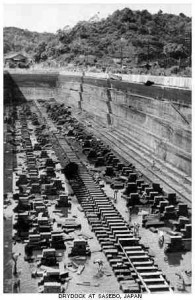 The USS MANSFIELD, a unit of DesRonNINE, was under the operational control of ComTaskGrp 95.2 (ComCruDiv in HELENA) upon departure from Sasebo, Japan on 26 September 1950. The ship proceeded with the Task Group, consisting of the HELENA, MANSFIELD and L.K. SWENSON, to the East Coast of Korea for blockade and gunfire support duties. En route a rendezvous was made with the USS BRUSH, which was returning to port following mine damage, and other blockade ships in her company (USS WORCHESTER, USS DEHAVEN, USS BOLSTER).
The USS MANSFIELD, a unit of DesRonNINE, was under the operational control of ComTaskGrp 95.2 (ComCruDiv in HELENA) upon departure from Sasebo, Japan on 26 September 1950. The ship proceeded with the Task Group, consisting of the HELENA, MANSFIELD and L.K. SWENSON, to the East Coast of Korea for blockade and gunfire support duties. En route a rendezvous was made with the USS BRUSH, which was returning to port following mine damage, and other blockade ships in her company (USS WORCHESTER, USS DEHAVEN, USS BOLSTER).
For the next three days and nights the MANSFIELD was accompanied by the USS SWENSON in providing a coastal traffic block at points up to Chumunjin Lat 37°56’N. Interdiction gunfire was carried out at night but no enemy traffic was indetified. The rapid advance of the ROK forces northward up the coastal highway, at this time, required great caution in selecting shell fire targets. The task was rendered more difficult by an operation order to remain outside of the 50 fathom curve due to suspected mines in the area. However, by observation and speaking to the coastal fishing boats waving ROK flags, and exchange of intelligence with other ships of the task group the gunfire targets were delineated safely.
 In addition to the L.K. SWENSON in company with the MANSFIELD, the task group ships in the coastal area included the USS HELENA, USS ENDICOTT, USS S.N. MOORE, USS THOMAS, and USS MADDOX with ComDesDiv 92 embarked.
In addition to the L.K. SWENSON in company with the MANSFIELD, the task group ships in the coastal area included the USS HELENA, USS ENDICOTT, USS S.N. MOORE, USS THOMAS, and USS MADDOX with ComDesDiv 92 embarked.
About 1230I on the 30th, an urgent dispatch directed the MANSFIELD and SWENSON to proceed at best speed possible to Lat 38°45’N, Long 128°15’E to assist a B-26 aircraft reported down at that point. The distance was about 60 miles north of the MANSFIELD. At 1445I the ship went to General Quarters and set Material Condition Able, executing this routine exercise with more thatn usual vigor upon hearing from the SAR plane on the scene that small arms fire had been received from the beach. At 1450I the ship reported on the scene and commenced searching. At 1500I, with the L.K. SWENSON lying to outside the 50 fathom curve, to cover our approach, the entry to Choson Ko begun. The approach was made at slow speed, heading so that the reported position of the plane wreckage would be on the starboard bow. A second plane was now on the scene, a B-178 with a rescue boat. The SAR plane, when requested to make another pass over the wreckage it had reported approximately 500 yards east of Toi To Island, again drew machine gun fire which could clearly be heard on the ship.
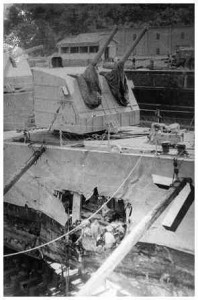 The ship had stopped engines at 1535I, and at 1536I both engines were backed to bring the way off, at a point 2,200 yards from the reported wreckage, in 12 fathoms of water. Some objects were now visible in the cove near the beach; a raft of logs about 3,000 yards to port, some net buoys about 3,000 yards ahead. At 1539I a sonar contact was identified as shoal, Chu Rai.
The ship had stopped engines at 1535I, and at 1536I both engines were backed to bring the way off, at a point 2,200 yards from the reported wreckage, in 12 fathoms of water. Some objects were now visible in the cove near the beach; a raft of logs about 3,000 yards to port, some net buoys about 3,000 yards ahead. At 1539I a sonar contact was identified as shoal, Chu Rai.
No sign of the suspected wreckage was seen by the many lookouts and officers on the bridge of the MANSFIELD. Neither was anything seen in the water near the ship. The mine lookout, recently stationed in the eyes of the ship with rifle and binoculars, reporting nothing.
Suddenly, a high order explosion was soon heard under the bow of the ship. A geyser of water rose up on the port side to the height of the gun director. While many of the watch were temporarily stunned by the detonation, the Commanding Officer backed both engines full. The ship was steered, while backing, through the same water she had entered. The engineering officer promptly left his station at repair central and rushed forward to begin damage control and rescue injured personnel. The bow was clearly observed to be sinking as soon as the explosion subsided.
 After backing clear to the vicinity of the L.K. SWENSON, a distance of about 4 miles, engines were stopped and an account made of the casualties and damage. Radio reports were sent to cognizant commanders. Early analysis of the damage accurately established the water tight bulkhead forward at frame 48. This bulkhead was shored while wounded were carried to the battle dressing station in the wardroom. the Commanding Officer called repeatedly for an estimate of casualties particularly dead and missing. Finally an all hands muster on abandon ship parade confirmed the previous on-battle-station muster of NONE missing or dead. After this cheerful report was passed to all hands, the work of treating the twenty-eight wounded, of building shores, and of pumping tanks proceeded with greater expedition. Three weeks after the explosion the fact that not a man was lost of even crippled remains a miracle.
After backing clear to the vicinity of the L.K. SWENSON, a distance of about 4 miles, engines were stopped and an account made of the casualties and damage. Radio reports were sent to cognizant commanders. Early analysis of the damage accurately established the water tight bulkhead forward at frame 48. This bulkhead was shored while wounded were carried to the battle dressing station in the wardroom. the Commanding Officer called repeatedly for an estimate of casualties particularly dead and missing. Finally an all hands muster on abandon ship parade confirmed the previous on-battle-station muster of NONE missing or dead. After this cheerful report was passed to all hands, the work of treating the twenty-eight wounded, of building shores, and of pumping tanks proceeded with greater expedition. Three weeks after the explosion the fact that not a man was lost of even crippled remains a miracle.
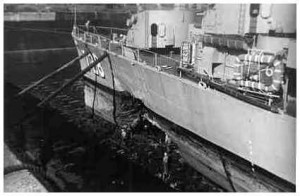 The labors of the MANSFIELD repair parties in this action are worth of note. The bow was clearly observed to be sinking, the damage control parties first efforts were to remove the wounded and shocked, them to determine the extent of the damage. The party penetrated the smoke and debris forward on the main deck and found that level relatively undamaged. Then thy tested the first platform deck, finding that deck above water but badly holed in the CPO mess room. When an attempt was made to go below that deck, the compartments were found to be flooded to a depth of several feet. Thus it was quickly determined that the first platform and the bulkhead at frame 48 was the water tight boundaries, and shoring was immediately begun on all decks. The wood shores provided on the ship were used early in this emergency, and in searching for more material for such use, the awning stanchions and magazine stowage supports proved of ideal value when set in place with a welding torch.
The labors of the MANSFIELD repair parties in this action are worth of note. The bow was clearly observed to be sinking, the damage control parties first efforts were to remove the wounded and shocked, them to determine the extent of the damage. The party penetrated the smoke and debris forward on the main deck and found that level relatively undamaged. Then thy tested the first platform deck, finding that deck above water but badly holed in the CPO mess room. When an attempt was made to go below that deck, the compartments were found to be flooded to a depth of several feet. Thus it was quickly determined that the first platform and the bulkhead at frame 48 was the water tight boundaries, and shoring was immediately begun on all decks. The wood shores provided on the ship were used early in this emergency, and in searching for more material for such use, the awning stanchions and magazine stowage supports proved of ideal value when set in place with a welding torch.
As no free-surfaced tanks were permitted in the accordance with standard instructions, the only need immediately evident was to pump forward tanks empty and after tanks full to keep the bow trim up. This was accomplished in short order using the emergency tank ejectors. The port anchor was jettisoned, resulting in a 3-4 inch rise of bow trim. Shoring of the deck with vertical welded stanchions was carried on. It is believed these damage control methods contributed much toward saving the damaged bow section.
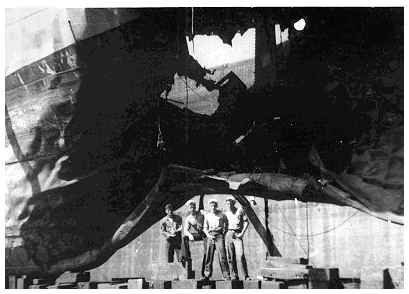 |
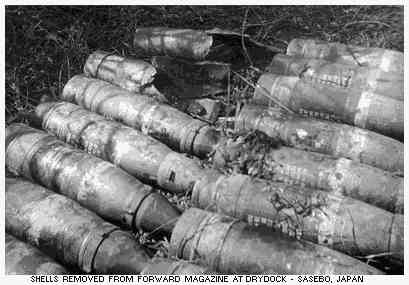 |
FIRST HAND ACCOUNT FROM GEORGE HENDERSON – USS HENDERSON 785
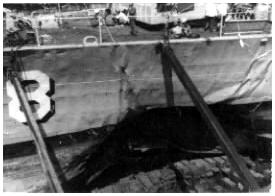 “On 9/30/1950 we received word that one of the destroyers in our squadron, the USS Mansfield, had struck a mine while on patrol duty off the Korean coast. 5 members of her crew were listed as missing and 48 were wounded *. It brought home to all of us that this was real and we were not indestructable. After returning to our home port in Sasebo, Japan, I went to the drydock where the Mansfield had been brought and this is a picture of her. You could drive a city bus through the hole in her keel.”
“On 9/30/1950 we received word that one of the destroyers in our squadron, the USS Mansfield, had struck a mine while on patrol duty off the Korean coast. 5 members of her crew were listed as missing and 48 were wounded *. It brought home to all of us that this was real and we were not indestructable. After returning to our home port in Sasebo, Japan, I went to the drydock where the Mansfield had been brought and this is a picture of her. You could drive a city bus through the hole in her keel.”
Please visit George’s website for more first hand accounts of his Navy days during the Korean War.
*Update from Rich Bowman 3.22.01: “The personnel casualties sustained as a result of the 30 September 1950 mining incident totaled twenty-eight. Nine of whom required transfer to the USS Helena and later to a hospital for emergency treatment. The wardroom was used as a battle dressing station, our commanding officer (Cdr. Headland) called repeatedly for an estimate of casualties particularly dead and missing. Finally an all hands muster on abandon ship parade confirmed the previous on-battle-station muster of NONE missing or dead. (Other official sources can be found at: Official War Diaries of the USS Mansfield and USN Operational Archives documents)”
CHRONOLOGICAL ORDER OF EVENTS
30 SEPTEMBER 1950
1227 Departed area of Point “Easy”, Lat 37°56’N, Long 128°54’E, in company with USS LYMAN K. SWENSON DD729 proceeding at 25 knots to a point Lat 38°45’N, Long 128°15;E, to investigate a report of a downed American B-26 in accordance CTG 95.2 instructions.
1239 Established radio communications with SAR plane.
1445 Small arms fire reported on the beach. Manned General Quarters Stations.
1450 Commenced approach to Chosen Ko. USS SWENSON standing by to seaward. MANSFIELD on course 286°T, speed 10 knots.
1500 Commenced entry, on course 205°T.
1504 Slowed to 5 knots.
1508 Increased to 10 knots.
1509 Plane reported possible wreckage 1/4 to 1/2 mile east of small island (Toi To).
1513 Slowed to 5 knots.
1533 SAR plane reported directly over wreckage.
1534 SAR plane reported objects at mouth of inner bay, appeared to be a life preserver and box.
1536 Objects, apparently logs, sighted on port beam 3000 yards.
1538 All engines stopped. Lying to.
1539 Sonar reported contact on port bow, 1200 to 1300 yards. Identified as 4 3/4 fathom shoal (Chu Rai).
1547 Explosion port side forward. All engines back full. Backed clear of minefield, lying to outside 50 fathom curve in vicinity L.K. SWENSON.
1737 All engines ahead 1/3 (3 knots).
1850 Changed speed to 8 knots.
2108 Stopped for transfer of wounded to USS HELENA.
2245 Underway at speed 8 knots as guide of formation.
2346 Changed speed to 10 knots.
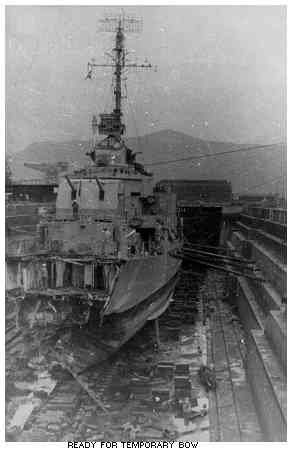 |
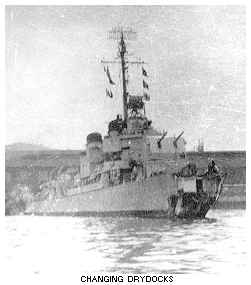 |
PEARL HARBOR, MONDAY DECEMBER 11, 1950
Two War-Torn U.S. Destroyers Here From Korea; Returning for Repairs
The 600 officers and men aboard two war scarred destroyers which limped into Pearl Harbor this morning are waiting impatiently to put out to sea again with the promise that they will be home for Christmas.
They arrived at 9 a.m. aboard the destroyers Brush and Mansfield, both of which suffered extensive underwater damage when they struck floating mines in Korean coastal waters in September.
After taking on fuel and supplies the ships are expected to leave late today for San Francisco and then to Puget Sound for shipyard overhauling.
HERE TWO WEEKS AGO
The destroyers left the Yokosuka naval base, Japan, two weeks ago after temporary repairs were made.
They struggled across the Pacific through the “worst weather I’ve seen in 20 years” on veteran navy man said.
Escorted by the cargo ship Achernar, the destroyers were slowed by the engine damage which the Brush had suffered and by the temporary “false bow” which was fitted across the front end of the Mansfield.
For several days, the ships could proceed at only three knots “because we couldn’t push the waves aside,” said Cmdr. Edwin H. Headland Jr., of Tacoma, Wash., skipper of the Mansfield.
The regular length of the Mansfield is 380 feet but with the temporary bow, she measures only 330 feet.
The destroyer lost 65 feet from her front end when her original how blasted by the enemy mine, was removed and sent by navy cargo ship to San Francisco to be repaired.
Twenty eight men were injured when the mine exploded under the Mansfield September 30 off the coast of Wonsan. The only life lost was that of the ship’s mascot, a mongrel dog named Pohang.
Cmdr. Headland gave three reasons why he felt casualties were so light:
1-The mine exploded under the keel of the ship – the strongest part of the vessel.
2-“The Mansfield is a lucky ship,” said Cmdr. Headland and suffered no damage in the Korean War up to that point. It was one of the “sitting duck” destroyers that paved the way for the Inchon invasion.
3-“Quick action in the part of the crew in bringing out injured and quick action by the doctor.”
Gunner’s mate 2nd class William L. Corcoran, 26, of Dorchester, Mass., has been recommended for a citation for his part in saving the wounded.
When Brush struck a mine off Tanchon on September 27, nine men were killed and 10 ere injured. The mine exploded amidship while the ship was traveling at 20 knots.
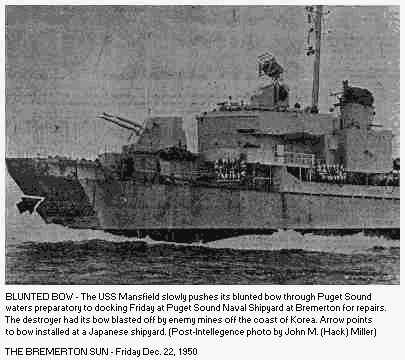 BREMERTON SUN SAT. DEC. 23, 1950 – First battle-damaged warships berthing here since World War II – the destroyers USS Mansfield and USS Brush – received warm welcomes yesterday despite rain laden winds.
BREMERTON SUN SAT. DEC. 23, 1950 – First battle-damaged warships berthing here since World War II – the destroyers USS Mansfield and USS Brush – received warm welcomes yesterday despite rain laden winds.
Countless little stories of heroism and humor are bared in the two destroyers’ logs of their important roles in Korean fighting.
In addition to naval and civilian officials, the 13th naval district’s band was on hand, playing both Christmas and military tunes as the mine-damaged vessels slipped into Pier 4 berths in Puget Sound Naval Shipyard. The welcoming was in contrast to that accorded the vessels when they first returned to the states from Korea last week.
No public or press reception was held in San Francisco. Yesterday, however, both newspaper and movie newsreel cameramen and reporters swarmed through the reception scene. Oddly, the seventh Korean patrol made by the Mansfield flagship of commander destroyer division Nine, was the unluckiest.
 On Sept. 30 the Mansfield suffered 20 casualties in striking a mine north of the Chumonshin area as it searched for a ditched B-26. Only the ship’s mascot, a mongrel dog named Pohang, was lost. The ship’s historian, with a touch of ironic humor, recorded in vital statistics: “Number of enemy mines destroyed, 1 (by ramming).”
On Sept. 30 the Mansfield suffered 20 casualties in striking a mine north of the Chumonshin area as it searched for a ditched B-26. Only the ship’s mascot, a mongrel dog named Pohang, was lost. The ship’s historian, with a touch of ironic humor, recorded in vital statistics: “Number of enemy mines destroyed, 1 (by ramming).”
One of the outstanding heroes of the mine blast was William L. Corcoran, gunner’s mate, second class, of Boston, Mass. Corcoran, who has been awarded the Silver Star, was credited with saving the lives of many crewmen by removing from the damaged bow area.
The Mansfield is most famed for her role as on of the five “sitting ducks”. She and sister destroyers stood off Wolmi Island to draw enemy fire – so that guns could be spotted and destroyed – before the successful Inchon landing.
 The Mansfield participated in a little mining activity herself, putting ashore on the east coast of Korea, a demolition team which mined a mile-long railroad tunnel.
The Mansfield participated in a little mining activity herself, putting ashore on the east coast of Korea, a demolition team which mined a mile-long railroad tunnel.
A North Korean train touched off the mines to halt some of the flow of material from northern industrial plants.
The Mansfield’s damaged bow was removed at the Sasebo, Japan shipyard and a temporary bow was affixed. The damaged bow came back aboard a cargo vessel and was transferred to the USS Achernar (AKA-53) for the final leg of the journey here.
The Brush suffered heavier casualties in a mine blast Sept. 27 off the northeast coast of Korea. The death toll now stands at 13, in addition to the injured and missing. E.N. Mitchell, fireman now on leave, was one of the five men swept over board. He made a two-mile swim to a small island and was eventually picked up by the destroyer USS Maddox. A second man was saved when he utilized a life raft dropped by a sea rescue plane until a vessel could pick him up. The other three still are listed as missing. The Mansfield and Brush berthed for repairs of battle damage and general overhaul after discharging their ammunition at Bangor naval ordnance depot. They were the first battle-damaged vessels reporting here since the World War II era when PSNS built, outfitted, repaired and overhauled a total of 394 ships.
Among them were the “five old ladies of Pearl Harbor,” the battleships USS California, maryland, Nevada, Tennessee and West Virginia. Also, the carriers USS Franklin and Bunker Hill – Japanese suicide plane victims – and the Enterprise, Lexington, Saratoga, Ticonderoga and Wasp.
Other battlewagons entering PSNS in wartime were the USS New Jersey, Pennsylvania, South Dakota and Washington, and Britain’s HMS Warspite.
In the cruiser class, the PSNS record lists the Minneapolis, Nashville, New Orleans, Pittsburgh and Wichita.

|
PERSONNEL
- The performance of the ship’s company was excellent in the crisis of a mine explosion on the USS MANSFIELD on 30 September 1950.
- All personnel were stationed in accordance with approved practice and organization. All reports, communication of damage, and repairs were made rapidly and efficiently. The repair parties reaction to the emergency was an obvious reflection of their training in “Damage Control Problems”. The wounded were evacuated and handled in a excellent manner. Effective control of flooding was established and the extent of damage was known shortly after being mined. Additional personnel, as needed, were taken from gun stations in the vicinity of the damage, for both rescue and repair work.
- The personnel of the ship had experienced the critical operation of the assault on the Inchon-Seoul area on 13-17 September, followed by continued operations except for two days in port for replenishment on 24-26 September. It is considered that their morale was at a high level at the time of the mining, in spite of an arduous, extended underway period. This spirit was sustained, it is believed, by the recognition of the War emergency, by the explanation of the current tactical situation to key personnel, and by daily informal reports of the local operations to all hands over the PA circuit.
- Certain members of the parties performed in the face of possible disaster with a manner which was highly commendable, if not heroic. In separate correspondence, recommendations for awards to those personnel will be made, in recognition of their outstanding efforts.
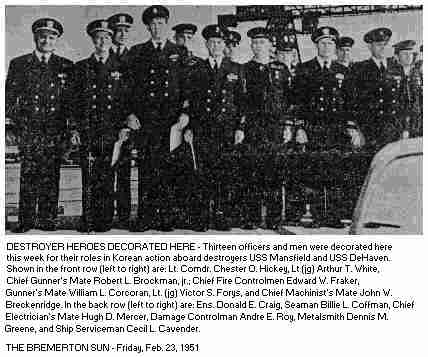 |
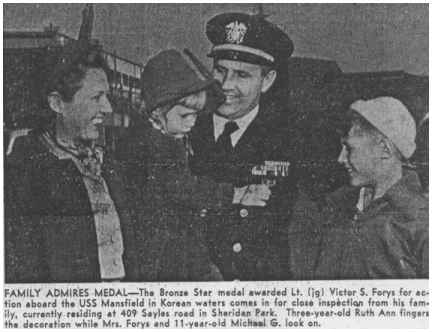 |
2 Navy Heroes Get Silver Stars
Action in Korean battle areas resulted in 13 more awards, including two Silver Star medals, for officers and men here while their destroyers are being repaired in Puget Sound naval shipyard.
Read Adm. Hugh E. Haven, shipyard commander, made the awards wednesday during ceremonies held near the ships under repair.
Silver stars were conferred upon Lt. Comdr. Chester O. Hickey of National City, Calif., and GM2 William L. Corcoran of Dorchester, Mass.
Both were decorated for their roles in evacuation of wounded comrades from the explosion area when their ship, the USS Mansfield struck an enemy mine Sept. 30, in North Korean waters.
Commander Hickey, materiel officer for destroyer squadron 9, was aboard the Mansfield and according to the citation, “displayed exceptional audacity and proficiency in evacuating the wounded and in repairing damage to the ship.”
Gunner Corcoran was cited for entering the devastated chief petty officers’ mess area and working heroically until he himself collapsed of wounds.
Action by the Silver Star winners in getting timely medical aid to the 28 injured Mansfield crewmen was a factor in saving of all casualties’ lives.
Seven other Mansfield officers and men were decorated as result of their roles in the same incident, including Lt. (jg) Victor S. Forys, 409 Sayles Road, CMM John W. Breckenridge, Savannah, Tenn., and SN Billie L. Coffman, Tucson, Ariz., who received Bronze Stars with combat distinguishing devices.
Commendation ribbons with combat distinguishing devices went to CEM Hugh D. Mercer of Bolivia, N.C., DC1 Andre E. Roy of Chelsea, Mass., and ME2 Dennis M. Greene, San Diego, Calif.
For gunnery action aboard the USS DeHaven in the Yongdok area July 23-27, four officers and men received commendation ribbons with combat distinguishing devices. They were:
Ens. Donald E. Craig, San Diego, Calif.; GGM Robert Lee Brockman, Jr., San Diego, Calif.; CFC Edward W. Fraker, Ocean Beach, Calif.; and Lt. (jg) Arthur T. White, La Jolla, Calif.
The following is a copy of the Citation presented to LT CMDR HICKEY for his Silver Star Medal. Courtesy of his son, Roger Hickey.
00 168228 – ljm – 3/28/51 – Prepared – Signed 19 APR 1951
The President of the United States takes pleasure in presenting the SILVER STAR MEDAL to
LIEUTENANT COMMANDER CHESTER OLIVER HICKEY
UNITED STATES NAVY
for service as set forth in the following
CITATION:
 “For conspicuous gallantry and intrepidity as Squadron Materiel Officer of Destroyer Squadron NINE, on board the U.S.S. MANSFIELD, in action against enemy aggressor forces in Korea on 30 September 1950. When his vessel struck an enemy mine in North Korean waters with resultant explosions and severe damage to the forward part of the ship, Lieutenant Commander Hickey calmly led the way into compartments filled with fumes, smoke and debris, and conducted the daring rescue of the wounded from the Chief Petty Officers’ quarters. In addition, he rendered valuable assistance to the Damage Control Officer in ascertaining the extent of the damage and in maintaining the effectiveness of the ship as a fighting unit. By his prompt and courageous actions, he aided materially in securing ready medical attention for the wounded and in providing effective control of the damage sustained, thereby upholding the highest traditions of the United States Naval Service.”
“For conspicuous gallantry and intrepidity as Squadron Materiel Officer of Destroyer Squadron NINE, on board the U.S.S. MANSFIELD, in action against enemy aggressor forces in Korea on 30 September 1950. When his vessel struck an enemy mine in North Korean waters with resultant explosions and severe damage to the forward part of the ship, Lieutenant Commander Hickey calmly led the way into compartments filled with fumes, smoke and debris, and conducted the daring rescue of the wounded from the Chief Petty Officers’ quarters. In addition, he rendered valuable assistance to the Damage Control Officer in ascertaining the extent of the damage and in maintaining the effectiveness of the ship as a fighting unit. By his prompt and courageous actions, he aided materially in securing ready medical attention for the wounded and in providing effective control of the damage sustained, thereby upholding the highest traditions of the United States Naval Service.”
For the President,
/s/ Francis P. Matthews
Secretary of the Navy
Copy to:
PubInfo, BuPers (2)
Pers-B42
ALL HANDS
Ref: ComNavForFarEast, Ser 839 of 1/30/51; (temp citation)
CASUALTIES
- Seriously injured (7):
- CHOWWING, Donald P., 344 75 99, FN, USN
- CORCORAN, William L., 761 58 53 GM2, USN
- HADEL, Julius M., 365 31 81, ICFA, USN
- MORRIS, Brooks H., 311 92 80, SD1, USN
- ROBERSON, Clarence V., 625 38 51, TN, USN
- SARGENT, Easu (n)., 830 94 12, SD3, USN
- WOOLLEY, Richard D., 797 80 50, SN, USN
- Not seriously injured (21):
- BAUGHMAN, Ralph F., 799 04 20, SA, USN
- BEECH, Admer C., 347 72 42, SN, USN
- CAVENDER, Cecil L., 569 07 42, SH3, USN
- COLLINS, Vernon D., 367 72 35, SN, USN
- DURRETT, Alfred E., 558 13 91, SN, USN
- GRANT, Ormond M., 226 0551, FN, USN
- GREENE, Dennis M., 657 67 98, ME2, USN
- GREER, Hearbert L., 569 06 70, SN, USN
- HASS, Robert L., 325 46 26, SN, USN
- HAYSE, Raymond M., 231 37 02 ENFN, USN
- HICKS, Frank C., 760 85 85, SA, USN
- JONES, Thomas G., 957 72 71, SN, USN
- JOYAL, Burton C., 325 46 26, SN, USN
- MASIGLA, Rafael I., 583 15 49, TN, USN
- MCCLANAHAN, Robert E., 569 00 25, SN, USN
- RODRIGUEZ, Alex (n)., 569 10 25, SN, USN
- SANDERS, Bernice (n)., 837 44 63, SN, USN
- SIMONS, Edward C., 274 05 94, QMC, USN
- STEGALL, John E., 276 16 86, SN, USN
- WHITE, Manly D., 253 29 19, GMSN, USN
- WOHLHART, Peter J., 300 86 34, SN, USN
SOURCE:
OPERATIONAL ARCHIVES BRANCH
NAVAL HISTORICAL CENTER
WASHINGTON, DC
Recently Declassified Photos of the Mine Incident
Photos courtesy of QM2 Richard Bowman (48-50)
from the NavSource Naval History Destroyer Archive Photographic History of the United States Navy

Severe mine damage below water line from mine explosion.
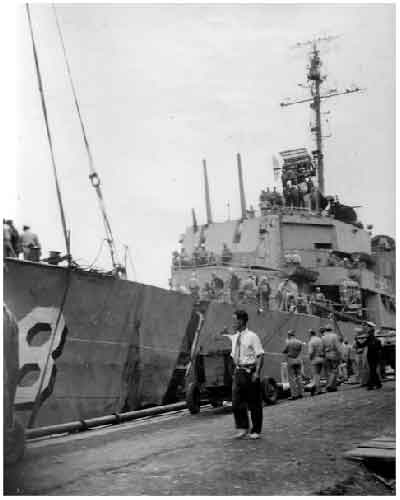
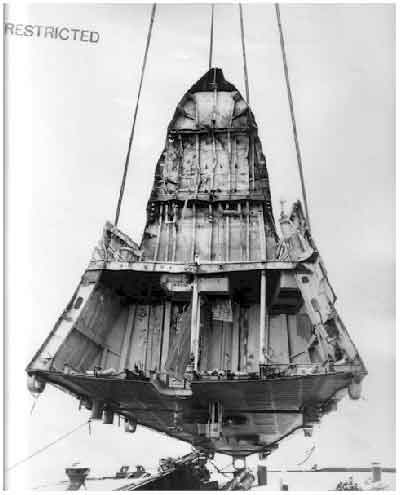
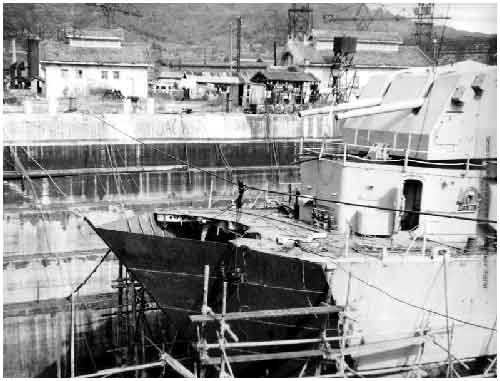
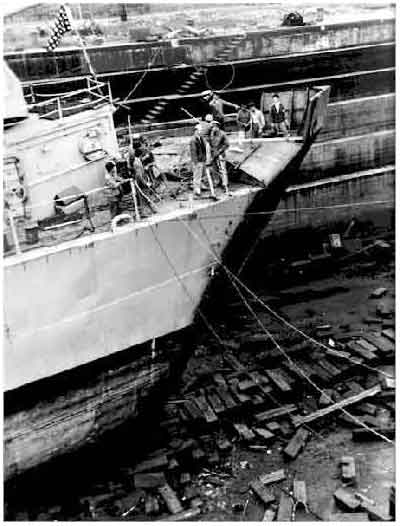
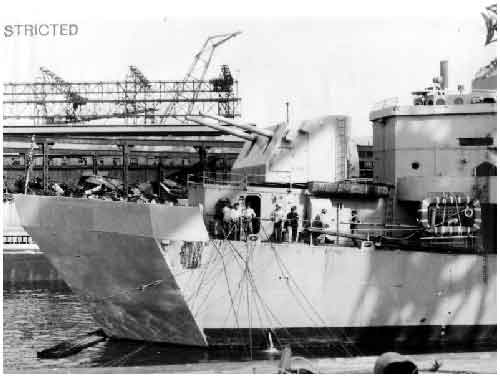
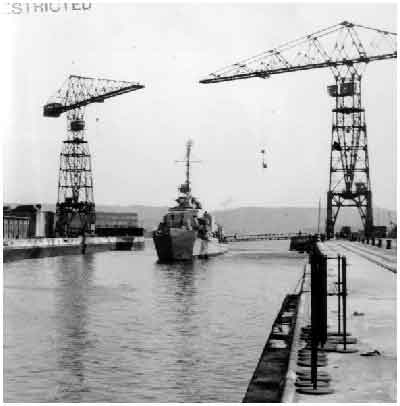
FB3-5:15:01
Serial: 144
21 September 1950
COMMANDER CRUISER DIVISION FIVE
C/O FLEET POST OFFICE
SAN FRANCISCO, CALIFORNIA
From: Commander Fire Support Group (CTG 90.6)
——(Commander Cruiser Division FIVE)
To: The Destroyer Element (TE 90.62)
—-(Commanding Officer, USS DEHAVEN (DD727)
—-(Commanding Officer, USS MANSFIELD (DD728)
—-(Commanding Officer, USS COLLETT (DD730)
—-(Commanding Officer, USS LYMAN K. SWENSON (DD729)
—-(Commanding Officer, USS HENDERSON (DD785)
—-(Commanding Officer, USS GURKE (DD783)
Subj: Commendation for Services rendered during the bombardment of Inchon, Korea, 13-15 September 1950
1. Commander Cruiser Division FIVE desires to commend the officers and crew of the ships under his command for their meritorious services rendered in support of this Task Group during its recent operation against Inchon, Korea.
2. The ship under your command distinguished itself by extraordinary heroism in action with the enemy and exhibiting gallantry and determination in overcoming difficult and hazardous conditions beyond the call of duty. During the period 3-15 September 1950, the DEHAVEN (DD727), MANSFIELD (DD728), LYMAN K. SWENSON (DD729), COLLETT (DD730), GURKE (DD783), and HENDERSON (DD785), navigated for the first time the difficult approaches to Inchon, Korea, through hostile enemy waters, under tide and current conditions well recognized for their navigational hazards and entered the well fortified harbor of INCHON. Anchoring within close range of the enemy shore defenses the destroyers returned with deliberate and decisive accuracy, the heavy counter battery fire of the hidden enemy gun emplacements ashore and, although receiving numerous hits and some casualties refused to depart from their assigned stations until their scheduled time of withdrawal, at which time they retired down the channel to await re entry for the next scheduled bombardment. Well knowing that with each entry the possibility of their meeting with additional resistance was increased, these ships transited a mine field, gallantly passed close to the shore fortification and, by determined precise bombardment effectively reduced the defenses of the port sufficiently to permit the sucessful landing of the United Nations Amphibious Forces on 15 September.
3. By their aggressive action and bold execution of the operation the destroyers were responsible for the landing of a large amphibious force within a narrow confined area and with the loss of scarcely any lives. Their outstanding conduct and successful execution of the operation have been an immediate major contribution to the war effort of the Korean Campaign and in keeping with the highest traditions of the United States Navy.
4. Commander Cruiser Division FIVE has forwarded to the Task Force Commander recommendations for awards proposed for those ships and personnel most vitally concerned in the attack on Inchon. In the meantime I trust you will express to the officers and crew of your ship my appreciation for their wholehearted and splendid support I received during the entire operation. To each and all a “Well Done”. I feel that we have definitely shortened the Korean Campaign by our successful achievement.
J.M. HIGGINS
Press Communique 19 September 1950
USS ROCHESTER OFF INCHON 19 SEPT X VICE ADMIRAL ARTHUR DEWEY STRUBLE COMMANDER OF JOINT TASK FORCE SEVEN WHICH COMPRISES THE AIR, GROUND AND SURFACE ELEMENTS EMPLOYED IN THE AMPHIBIOUS INVASION AT INCHON TODAY ANNOUNCED THE NAMES OF THE SHIPS THAT PARTICIPATED IN EARLY PHASES OF THE ASSAULT.
THE FIVE DESTROYERS THAT PERFORMED THE MISSION OF DRAWING ENEMY FIRE AT POINT BLANK RANGE FROM WOLMI DO ISLAND ON D DAY MINUS TWO (SEPT 13) WERE THE MANSFIELD, DE HAVEN, LYMAN K. SWENSON, COLLETT AND GURKE. THEY MOVED IN ON WOLMI DO AT NOON ON THE THIRTEENTH IN THE ORDER NAMED, LED BY THE MANSFIELD FLAGSHIP OF COMMANDER DESRON NINE.
THE OBJECT WAS TO LOCATE ENEMY SHORE BATTERIES SO THAT THEY COULD BE DESTROYED BY GUNFIRE AND AERIAL BOMBING BEFORE THE MARINES MADE THE INITIAL LANDING ON WOLMI DO. THE MISSION WAS SUCCESSFUL BUT IN THE ENSUING SHORT RANGE DUEL WITH ENEMY SHORE BATTERIES THE COLLETT WAS HIT NINE TIMES WITH THREE WOUNDED AND THE GURKE WAS HIT THREE TIMES WITH TWO WOUNDED. THE SWENSON SUSTAINED A NEAR MISS WITH ONE WOUNDED AND ONE KILLED.
ON D DAY MINUS ONE THE DESTROYERS WERE SENT IN AGAIN EXCEPT THAT THE HENDERSON REPLACED THE COLLETT WHICH WAS ASSIGNED THE TASK OF LOCATING AND EXPLODING MINES IN THE HARBOR APPROACHES.
ON D DAY THE SOUTHERLAND JOINED THE DESTROYER GROUP WHICH STAYED IN FOR CLOSE FIRE SUPPORT OF LANDING ON WOLMI AND LATER ON RED AND BLUE BEACHES AT INCHON.
AMERICAN CRUISERS PARTICIPATING IN THE ACTION INCLUDED THE ROCHESTER AND TOLEDO AND THE BRITISH CRUISERS KENYA AND JAMAICA. THE CRUISERS LONG RANGE GUNS WERE USED EFFECTIVELY TO HELP SILENCE SHORE BATTERIES ON WOLMI DO AND AGAINST ENEMY ARTILLERY LOCATED IN INCHON.
CARRIER PARTICIPATION IN THE EARLY PHASES OF THE OPERATION INCLUDED TWO FLEET CARRIERS, THE PHILIPPINE SEA AND THE VALLEY FORGE, TWO BRITISH ESCORT CARRIERS THE SICILY AND THE BADOENG STRAIT AND THE BRITISH LIGHT CARRIER TRIUMPH.
THE CARRIERS PERFORMED A NUMBER OF IMPORTANT MISSIONS. THEY MADE HEAVY STRIKES AGAINST THE FORTIFICATIONS OF WOLMI DO AND INCHON, STRAFFED ENEMY MOVEMENTS OF TROOPS AND TANKS TOWARD INCHON AND PROVIDED AIRPLANE SPOTTING FOR THE CRUISER GUNFIRE.
THE NET RESULT OF THE COORDINATED ASSAULT WAS A SUCCESSFUL LANDING WITH A MINIMUM OF CASUALTIES.
THE ONLY SHIP HIT SUFFICIENTLY TO REQUIRE WITHDRAWAL WAS THE COLLETT WHICH WAS SAILED FOR A BASE REPAIR PORT ON SEPTEMBER 18TH. ON DEPARTURE COMMANDER JOINT TASK FORCE SEVEN SENT A MESSAGE COMPLIMENTING THE OFFICERS AND MEN FOR THEIR GALLANTRY IN ACTION.
Thanks to Tom Cheatum webmaster of the USS GURKE web site
THE SECRETARY OF THE NAVY
WASHINGTON
The Secretary of the Navy takes pleasure in commending
TASK ELEMENT 90.62
consisting of the USS MANSFIELD, USS DEHAVEN, USS HENDERSON, USS GURKE, USS LYMAN K. SWENSON and USS COLLETT for service as set forth in the following
CITATION:
“For outstanding heroism in action against enemy aggressor forces in Korea from 13 to 15 September 1950. Skillfully navigating the extremely difficult and hazardous approaches to enemy-held Inchon in advance of the initial assault against that fortress, Task Element 90.62 coolly entered the strongly fortified harbor and anchored within close range of hostile gun positions. Defying the deadly barrage of heavy enemy shore-battery fire delivered from a myriad of hidden gun emplacements scattered along the coastline, the gallant destroyers of this Element courageously proceeded to launch an accurate and crushing fire attack in the first of a series of well-planned and brilliantly executed bombardments which culminated in the reduction of the port’s defenses and the successful landing of friendly forces at Inch’on on 15 September 1950. Although sustaining several casualties and numerous hits from the roaring enemy shore batteries, these ships repeatedly refused to leave their assigned stations and boldly contained to return the heavy counterfire of hostile guns until their scheduled time of withdrawal. Fully aware that with each successive entry into the treacherous channel the peril of meeting increased resistance was greatly intensified, they braved the hazards of a hostile mine field, passed dangerously close to the enemy’s shore fortifications and unleashed a furious bombardment which eventually neutralized the port defenses sufficiently to permit the successful amphibious landings. An aggressive and intrepid fighting unit, the daring officers and men of Task Element 90.62 achieved a splendid combat record which attests the teamwork, courage and skill of the entire Destroyer Element and enhances the finest traditions of the United States Naval Service.”
All personnel attached to and serving on board the above mentioned destroyers from 13 to 15 September 1950 are hereby authorized to wear the NAVY UNIT COMMENDATION Ribbon.
* Thanks to Roger Hickey for sending me a copy of the above citation.
Mine Detonation Incident 9 Novemeber 1952
[Photo courtesy of Pat McGrath]
 Here is the official log entry (transcribed) for Sunday, 9 November 1952. Thanks to Don Harrington for making it available:
Here is the official log entry (transcribed) for Sunday, 9 November 1952. Thanks to Don Harrington for making it available:
1557 – Sighted possible mine to port, c/s to 10 knots (88rpm) . Using various courses to investigate.
(Signed) J. A. WILKINSON,
LT., U.S.N.R.
1618 – Steaming as before. Contact identified as a definit (sic) mine. Mine is one third out of the water, barnacle encrusted, one horn showing, two horns missing, rusty, securing padeye showing on the bottom, access plate on top and about three (3) feet in diameter. Probably Russian made Mark 26 type mine.
1620 – Mine taken under fire with small arms and 40MM fire.
1642- Mine detonated with 40MM fire about 250 yards off starboard beam. Explosion was bright red flash followed by thick black smoke. Flume extended about 250 feet into the air. Fired 76 rounds of 40MM HEIT projectiles.
1643 – Came to course 000° (t) and pgc, 000 psc, speed 15 knots (135rpm)
(Signed) R. C. WADDEL,
ENS, U.S.N.
The following are personal recollections of the events from those who were there. If you have an anecdote about this incident, please send it to me. Thanks, Karl
GM2 Beryl Jensen: “I was assigned to the Mansfield in April of 1951 and served aboard until my discharge in November 1954. I attained the rank of GM2, working with the 40MM, 5″38, and the 3″ 50 rapid fire, after havng gone to school in DC for this new weapon. During my tour on the Mansfield, we did 3 tours to Korea; on the East coast, doing shore bombardment, and carrier escort, during flight operations.
The one thing I do remember vividly, was when we blew up a floating mine near Wonson Harbor in November of 1952. As I had the responsibility of the 2 – 40MM mounts just aft of the bridge, the captain directed us to commence firing with the mount on the starboard side. And we got it before it got us. ”
LTjg Donald Harrington:“I have been thinking more about the exploding mine incident in November of 1952 (all confirmed in the log sheets that we obtained from the Bureau of Archives) and hope you (Beryl) were the gunner on the director for 40MM mount #41 – in any event, you were on board so the rest of the story is: Bob Waddell, who had just qualified as OOD underway and I (JOOD), along with Art Waldie, were on the bridge. The sea was as flat as a mirror and Art said to me ‘are there any buoys in this area’ ? I was immediately upset, as I knew what he had seen, and as you know, the lookouts (poor rookies) had no idea what they were looking for — anyhow, there, dead ahead and comfortably far enough away, was a big ass floating mine – I raged at him with the typical == godam it you could have just said mine ahead without the cute stuff about buoys about 8 miles off shore —- LT Howard Phillips (finest officer I may have ever known was a short timer and in addition to wearing the bullet proof jackets, also brought a movie camera on board for his last few months) tried to hit the mine with an M1 and I even tried it and missed like the gunners mates and then the Captain turned the job over to the 40MM and about 15 rounds later == BLAMOOOO !!! the mine was hit and detonated stbd side close enough that we all ducked.”
RDSN Pat McGrath:“I recall that Keith Crow, one of the Radar Gang, was also out on the starboard side with some others — and a piece of shrapnel parted his hair! Somebody up there liked him.”
The following photos courtesy of
Dick Herrington, RM3 1958/61
“You can see the extensive tear down that went on. I don’t know what they did below the main deck, but they replaced an awful lot of the large machinery. If my memory serves me right, most of the structure that was replaced above the main deck was aluminum. Whatever they did we were faster when we went back into the water and could easily stay with the carrier during launch and recovery.”
“I was aboard from Oct. ‘ 58 until sept. ‘ 61 and was in the skeleton crew that stayed aboard through FRAM. I was a radionman and it was good duty for me, as my watch was in a nice clean office ashore. There were only two of us and we were excused from working aboard the ship.”
The following pictures courtesy of BT1 Jack Ray Huffman [deceased] (47-51). Donated by his son Darrel Huffman for use on this website and for the archives of the USS Mansfield Association.
DISCLAIMER: ALL NAMES AND EVENTS WITHDRAWN FROM A 50+ YEAR OLD MEMORY BANK!
CORRECTIONS AND ADDITIONS WELCOMED
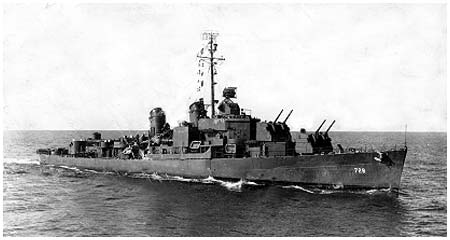
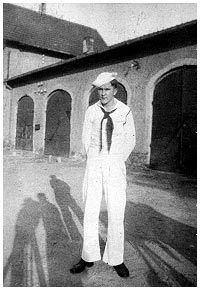 BT1 JACK RAY HUFFMAN [deceased]
BT1 JACK RAY HUFFMAN [deceased]
BT1 Jack Ray Huffman served aboard the USS Mansfield from March 1946 – January 1951. He went from S 2/C, F2/C, F1/C, WT3, BT2, BT1 while on the Mansfield. Some of his duties were Oil King; Burnerman; Checkman; Top Auxiliary and Top Fireroom Steaming Watches; Fireroom Supervisor; Boiler Repair Petty Officer in Charge #1 and #2 Fireroom; Top Engine room Watch.
My thanks to his son Darrel Huffman for donating the photo albums to the Mansfield Association and for use on this website.
The pictures of the mine damage are remarkable and probably being seen for the first time by the general public. I’ve also scanned many photos of Jack’s shipmates.
There are several photos of a family nature and many of general scenes which I chose not to put on the website. The albums will be sent to the Mansfield Association and a “new” album created for use of the Association and all personal and unused photos will be returned to the Huffman family.
Thanks for Shipmate ETN2 J.J. Marold for sending a copy of the Awards Ceremony progam.
| MEN RECEIVING AWARDS AT TODAY’S CEREMONY
BRONZE STAR MEDAL CDR. JACK R. GRIFFIN NAVY COMMENDATION MEDAL WITH COMBAT “V” LT. GOSNELL NAVY ACHIEVEMENT MEDAL WITH COMBAT “V” LTJG ASHBURN COMMANDER 7th FLEET LETTERS OF COMMENDATION RM3 BAKER MEN WHO HAVE RECEIVED AWARDS DURING MANSFIELD’S 1966-68 WESTPAC DEPLOYMENT BRONZE STAR MEDAL LCDR. KESTELOOT PURPLE HEART MM2 ARCHER (KIA) NAVY COMMENDATION MEDAL LCDR. BLAES NAVY ACHIEVEMENT MEDAL FTCS ADAMS COMMANDER 7th FLEET LETTERS OF COMMENDATION BT1 ARMSTRONG |
Thanks for Shipmate ETN2 J.J. Marold for sending a copy of the Awards Ceremony progam.
THE RECOGNITION TO BE GIVEN THESE MEN IS WELL EARNED. THROUGH THEIR EFFORTS AND BY EFFECTIVE ALLOCATION OF RESOURCES BETWEEN 25 JUNE 1966 AND 9 JUNE 1968, USS MANSFIELD INFLICTED TREMENDOUS DAMAGE UPON THE ENEMY IN VIETNAM. AS A RESULT OF THE WORK OF THESE MEN AND THEIR SHIPMATES THE DESTROYER MANSFIELD WAS ABLE TO MEET ALL COMMITMENTS IN AN OUTSTANDING MANNER, COMPILING AN ENVIABLE COMBAT RECORD. A LIST OF THE GUN DAMAGE ASSESSMENTS COVERING A SMALL PORTION OF THE GUNNERY REFLECTS SOME OF USS MANSFIELD’S CONTRIBUTION TO OUR NATIONS EFFORT IN VIETNAM.
GUN DAMAGE ASSESSMENT WOULD SURELY HAVE BEEN MUCH MORE EXTENSIVE EXCEPT THAT MANY MANY MISSIONS WERE UNOBSERVED OR VEGETATION AND DISTANCE PRECLUDED OBSERVATION. DURING THE TWO YEAR PERIOD SPENT COMPILING THIS RECORD, THE SHIP INVOKED MANY HEARTENING RESPONSES FROM OUR FORCES ASHORE. SOME OF THE HIGHLIGHTS FOLLOW:
|


